ARCHIVED – 2022 Annual Report to Parliament on Immigration
For the period ending
December 31, 2021
Immigration, Refugees and Citizenship Canada
ISSN 1706-3329
Table of Contents
- Message from the Minister of Immigration, Refugees and Citizenship
- Key highlights for immigration to Canada 2021
- Introduction
- Canada’s approach to immigration
- Temporary resident programs and volumes
- Permanent immigration to Canada
- Francophone immigration outside of Quebec
- Canada’s next permanent resident Immigration Levels Plan
- Federal-provincial-territorial partnerships
- International engagement
- Anti-Racism at Immigration, Refugees and Citizenship Canada
- Gender and diversity considerations in immigration
- Annex 1: Section 94 and Section 22.1 of the Immigration and Refugee Protection Act
- Annex 2: Tables
- Annex 3: Temporary migration reporting
- Annex 4: Ministerial Instructions
Message from the Minister of Immigration, Refugees and Citizenship
As Minister of Immigration, Refugees and Citizenship, I am pleased to present the 2022 Annual Report to Parliament on Immigration.
Immigration provides essential contributions to Canada’s culture, economy, and population growth. It is also the means by which Canada proudly maintains its standing as a leading refugee resettlement country. Making immigration work for Canada is a complex undertaking.
Even with the difficulties posed by the COVID-19 and multiple humanitarian crises, the Department continued to meet its commitments across its many lines of business. Through an unprecedented period of uncertainty and change, Canada has maintained an immigration system that supports Canada’s economic recovery and growth, reunites families, and upholds our humanitarian tradition.
In 2021, Canada welcomed the most immigrants in a single year in its history, with nearly 406,000 permanent residents in the economic, family reunification, and refugee/humanitarian streams. This was a remarkable achievement for Canada and relied on robust collaboration and partnership among all levels of government.
Over 191,000 work and study permit holders transitioned from temporary to permanent resident status. We welcomed over 415,000 temporary work permit holders and over 445,000 study permit holders. These newcomers increase the diversity of Canadian communities, strengthen our economy and grow our learning institutions. These are encouraging numbers, but there is room for improvement.
Canada is a destination of choice for many people seeking a new home. This results in a large volume of applications each year. To address processing delays, we have devoted capacity to processing existing clients and increasing efficiency, as well as improving digital services and client delivery.
While many of the initial disruptions caused by the COVID-19 pandemic have been resolved, the Department continues to face long-term impacts to operations across the globe, challenging its ability to finalize applications. Immigration, Refugees and Citizenship Canada has committed $85 million for the Department and partners to improve outcomes in this area, including the addition of over 1,200 new employees to support processing of applications.
The Department’s refugee protection efforts were also a key area of focus in 2021. Immediately following the Taliban’s return to power in Afghanistan, the Government of Canada pledged to bring Afghan nationals to Canada. This includes those who assisted the Government of Canada and its allies, as well as women leaders, human rights defenders, journalists and those who helped them, persecuted ethnic and religious minorities, 2SLGBTQI+ individuals, and family members of previously resettled interpreters.
To support human rights defenders specifically, Immigration, Refugees and Citizenship Canada developed a new refugee stream, informed by applying Gender-based Analysis Plus to ensure that the stream best met the needs of those most in need of protection. The Department also continued to engage stakeholders and employees throughout 2021 on its Anti-Racism Strategy.
As our recovery from the difficulties of the past two years gathers pace, our immigration system will remain an essential factor in Canada’s diversity and prosperity, which includes supporting labour force growth and supplying in-demand skills across our broad range of programs. We see this also in our work to welcome Ukrainians to safety following the invasion of their country, and we will see it in our ongoing commitment to bring workers, students, and newcomers to Canada through our 2023–25 Immigration Levels Plan.
In 2021, the Department made progress on the Economic Mobility Pathways Pilot, which aims to address Canadian labour shortages while providing durable solutions for refugees with the skills and qualifications that Canadian employers need. The intake of applications for phase 2 of the Economic Mobility Pathways Pilot started in December 2021. The Department has committed to further expand this Pilot to welcome 2,000 skilled refugees to fill specific labour shortages in high-demand sectors, such as healthcare.
Another significant milestone to highlight is Bill C-19, the Budget Implementation Act, which received Royal Assent in June 2022, and implements many of the government’s commitments to grow our economy and make life more affordable for Canadians. It will make it easier for skilled immigrants to make Canada their home by improving the government’s ability to select applicants from the Express Entry system who fill labour shortages and match the needs of Canada’s businesses.
The Department faced considerable service challenges through 2021, principally due to the ongoing pandemic. It countered this unique period of adversity with a dedicated, responsive workforce, a forward-thinking modernization agenda and bold vision for the future.
I invite you to learn more about the Department’s accomplishments and ongoing priorities in the Annual Report to Parliament on Immigration.
Minister of Immigration, Refugees and Citizenship
Key highlights for immigration to Canada 2021
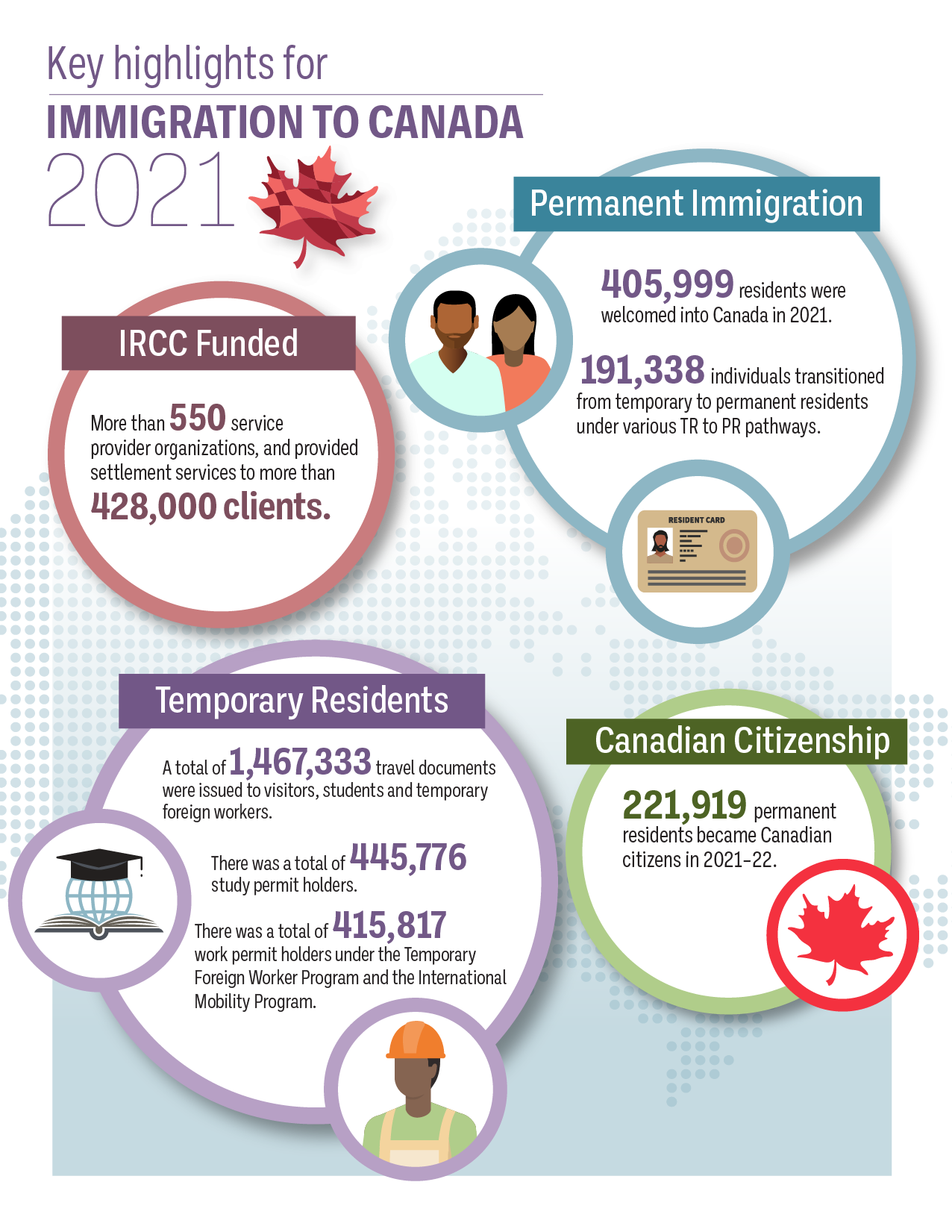
Text version: Key Highlights for Immigration to Canada 2021
Permanent Immigration
405,999 permanent residents were welcomed into Canada in 2021.
191,338 individuals transitioned from temporary to permanent residents under various TR to PR pathways.
IRCC Funded
More than 550 service provider organizations, and provided settlement services to more than 428,000 clients.
Temporary Residents
A total 1,467,333 travel documents were issued to visitors, students, and temporary foreign workers.
There was a total 445,776 Study Permit Holders.
There was a total 415,817 work permit holders under the Temporary Foreign Worker Program and the International Mobility Program.
Canadian Citizenship
221,919 permanent residents became Canadian citizens in 2021–22.
Introduction
The Annual Report to Parliament on Immigration is a requirement of the Immigration and Refugee Protection Act. It provides the Minister of Immigration, Refugees and Citizenship with the opportunity to inform Parliament and Canadians of key highlights and related information on immigration to Canada. It also offers information on successes and challenges in welcoming newcomers to Canada.
This report sets out information and statistical details regarding temporary resident volumes and permanent resident admissions, and provides the planned number of upcoming permanent resident admissions. In addition, it outlines the efforts undertaken with provinces and territories in our shared responsibility of supporting immigration, highlights efforts to support and promote Francophone immigration, and includes an analysis of gender and diversity considerations in Canada’s approach to immigration.
The 2022 Annual Report to Parliament on Immigration focuses on immigration results that were achieved in 2021, although publication takes place in the following calendar year to allow Immigration, Refugees and Citizenship Canada (IRCC) the opportunity to obtain final information from the preceding calendar year.
About the data in this report
Admissions data can be found in Annexes 2 and 3, as well as on the Government of Canada’s Open data portal and in the facts and figures published by IRCC.
Data in this report that were derived from IRCC sources may differ from those reported in other publications; these differences reflect typical adjustments to IRCC’s administrative data files over time. As the data in this report are taken from a single point in time, it is expected that there may be minor changes as additional information becomes available.
Canada’s approach to immigration
Why immigration is important to Canada
For over a century, immigration has been a means to support population and economic growth as well as cultural diversity across Canada. Millions of eligible people from around the world have chosen to reside in Canada and make it their new home. Whether seeking better economic opportunities, the ability to reunite with family members, or protection, Canada has consistently supported individuals to come to Canada to build on its strong economic and social foundations.
2021: A year of continued adaptability
In response to the ongoing challenges of the COVID-19 pandemic in 2021, Immigration, Refugees and Citizenship Canada (IRCC) continued to implement innovative solutions to support immigration and cross-border mobility for newcomers and refugees, while continuing to protect the health and safety of those who live in Canada. At the same time, the Department remained focused on Canada’s economic recovery and continuing to deliver on its mandate, core programming, and critical services. In doing so, IRCC responded to emerging issues and emergencies, which included delivering on the Government of Canada’s mandate letter commitment to resettle at least 40,000 Afghan refugees by 2024, and implemented the most ambitious level of planned permanent resident admissions in Canada’s history.
One of the key challenges related to the pandemic was the backlog in processing applications for permanent residents and temporary resident permits. In November 2021, IRCC had a processing inventory of nearly 1.8 million immigration applications. While the government sets immigration levels each year through the Multi-Year Levels Plan, which were achieved in 2021, the backlog is due to a range of factors. The factors contributing to the backlog include unprecedented demand, ongoing international travel restrictions, border restrictions, competing operational pressures, and the inability on the part of clients to obtain documentation due to the effects of COVID-19. These factors created issues in processing applications efficiently and effectively within established timelines.
To mitigate the risks and reduce the impacts related to persistent backlogs and wait times, IRCC continued to improve digital services and approaches to client delivery. This included increased leveraging of digital innovations through the launch of the Permanent Resident Digital Intake Portal, employing the use of responsible advanced data analytics in immigration systems, and continuing the digitization of paper-based applications.
For instance, to facilitate access to IRCC portals and e-Apps, IRCC deployed a feature that provides clients with the ability to apply with the help of a representative. The feature went live on November 30, 2021.
IRCC continues to improve the e-App to make it accessible to more clients. Further expansion and the addition of new functionalities are planned and will help reduce the intake of paper applications and allow the transition to a digital process.
Highlight on the Digital Platform Modernization program
IRCC is on a multi-year transformational digital journey to modernize its suite of programs and services, including the way they are managed and delivered, to better meet the changing needs and expectations of clients.
IRCC’s digital transformation will be delivered through the Digital Platform Modernization (DPM) program (2020–26), a multi-year initiative that will bring the Department and its programs and services into the digital age in a strategically planned and coordinated way. Many government departments and agencies involved in migration rely on information gathered, processed, managed, and made accessible by IRCC. The DPM program will re-imagine and re-design new digital business processes, improved ways of working, and a modern technology platform that will improve the overall client, employee, and partner experience while maintaining the health, safety, and security of Canadians.
Immigration contributes to Canada’s prosperity
Immigration is vital to our economy, our communities, and our national identity as a country that is diverse and welcoming of everyone. Indeed, multiculturalism is one of Canada’s great success stories and an example to the world. Every year, Canada welcomes hundreds of thousands of permanent residents, temporary foreign workers (TFWs), students, and visitors. Canada also supports the reunification of families and the protection of refugees and persons at risk. During the COVID-19 pandemic, newcomers played an essential role on our front lines across the country, including in hospitals, food production, agricultural operations on farms big and small, the manufacturing sector, and the transportation sector.
Immigration is critical to Canada’s economic growth, and is key to supporting economic recovery:
- Immigration accounts for as much as 90% of labour force growth in Canada and approximately 75% of population growth.Footnote 1
- International students make a significant contribution to the Canadian economy, with some estimating they contributed $23.5 billion to Canada’s gross domestic product (GDP) in 2019.Footnote 2
- Temporary and permanent residents are able to meet specific labour market needs in Canada, and make up relatively high proportions of the work force in some industrial sectors.Footnote 3 In the future, more temporary and permanent residents are needed to address labour shortages and contribute to economic prosperity in Canada.
Importance of Canada’s multi-Year Immigration Levels Plan
Under the Immigration and Refugee Protection Act, IRCC is required to table its Immigration Levels Plan on or before November 1, with exceptions to tabling dates in the case of election years. The Immigration Levels Plan, in general, delivers long-term benefits to Canada, supports short-term economic growth and addresses labour market needs, and ensures a well-managed system that maintains public confidence within a well-managed immigration system.
Permanent resident admissions are planned over a three-year timeframe and are assisted by ongoing supports delivered through IRCC’s Settlement Program. Of particular note, last year saw the take-over of Afghanistan by the Taliban on August 15,2021, to which Canada responded quickly by committing to welcome at least 40,000 Afghan refugees by 2024, exceeding the admissions level set in the Multi-Year Levels Plan.
In 2021, Canada welcomed the most immigrants in a single year in its history, with 405,999 permanent residents, representing an increase of 120% from 2020. This was made possible, despite the challenges posed by the pandemic, by ramping up production and leveraging innovative practices. Examples include pivoting to a focus on applicants already living in Canada by introducing time-limited Temporary Resident (TR) to Permanent Resident (PR) pathways, and using virtual landings and the digitization of paper applications to enable faster processing. The historic number of permanent residents admitted in 2021 played a key role in supporting economic recovery during the pandemic and filling critical labour gaps in the essential services sectors.
In February 2022, Canada tabled its 2022–24 Immigration Levels Plan. It aimed to continue welcoming immigrants at a rate of about 1% of Canada’s population per year, including 431,645 permanent residents in 2022, 447,055 in 2023, and 451,000 in 2024. With an increased focus on supporting our economic resurgence and post-pandemic growth, we increased our Levels Plan to further address the demand for increased labour, reuniting families, and resettling the world’s most vulnerable.Footnote 4
The 2023–25 Immigration Levels plan, included further down in this report, will continue to play an important role in Canada’s economic growth and recovery, from filling labour shortages and closing labour market gaps to ensuring employers who will provide jobs in the industries of the future can become established and grow in Canada.
Humanitarian tradition and resettlement of Afghan refugees
In 2021, Canada maintained a strong tradition of offering protection to those in need, and continued to steadfastly fulfill its international legal obligations with respect to refugees. Canada also maintained its proud humanitarian tradition of being the top refugee resettlement country in the world, resettling 20,428 refugees in 2021, according to the United Nations Refugee Agency (UNHCR) Global Trends Report.
As part of this tradition, Canada’s top five admissions of permanent residents as resettled refugees by country of citizenship in 2021, include: Afghanistan (6,105)Footnote 5, Syria (4,195), Eritrea (3,674), Iraq (1,520), and the Democratic Republic of Somalia (1,297).
The Government of Canada committed in 2021 to welcome at least 40,000 Afghan refugees and vulnerable persons by 2024 in response to the crisis in Afghanistan. This is being done through several program and policy initiatives in IRCC, including a humanitarian program, a special immigration program for Afghans who assisted the Government of Canada, and a pathway for extended family members of former Afghan interpreters who previously immigrated to Canada under programs in 2009 and 2012.
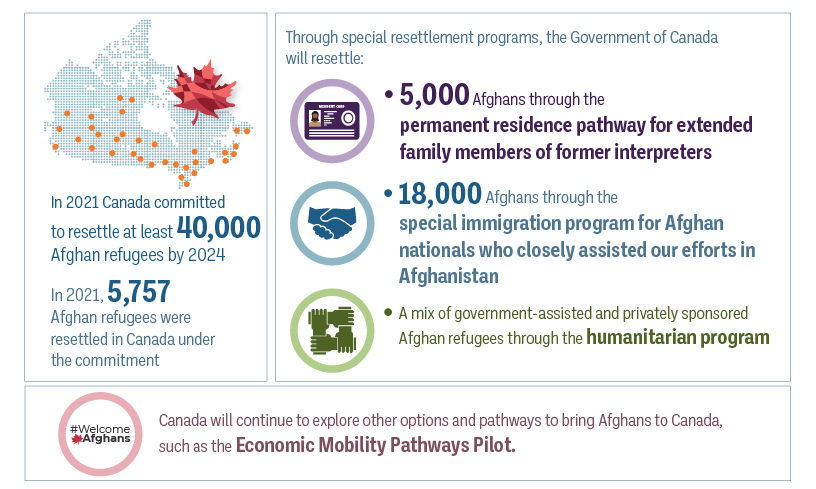
Text version: Humanitarian tradition and resettlement of Afghan refugees
In 2021 Canada committed to resettle at least 40,000 Afghan refugees by 2024
In 2021, 5,757 Afghan refugees were resettled in Canada under the commitment
Through special resettlement programs, the Government of Canada will resettle:
- 5,000 Afghans through the permanent residence pathway for extended family members of former interpreters
- 18,000 Afghans through the special immigration program for Afghan nationals who closely assisted our efforts in Afghanistan
- A mix of government-assisted and privately sponsored Afghan refugees through the humanitarian program
Canada will continue to explore other options and pathways to bring Afghans to Canada, such as the Economic Mobility Pathways Pilot.
The rapid surrender of the Afghan government to the Taliban in the days leading up to the withdrawal of U.S. and other allied forces prompted a large-scale international evacuation effort that resulted in 3,700 people, including Canadian citizens and permanent residents, being evacuated to Canada before the air-bridge closed on August 31, 2021. This evacuation was carried out using Canadian Armed Forces flights, Global Affairs Canada charters, and space on flights provided by allied countries, mainly the United States.
Given the rapid escalation of events in Afghanistan, the Government of Canada announced on August 13, 2021 that it would resettle 20,000 Afghan nationals. On September 27, 2021, while addressing the United Nations General Assembly, the Government of Canada doubled its commitment to 40,000. The commitment to resettle at least 40,000 Afghan nationals was subsequently confirmed in IRCC’s ministerial mandate letter in December 2021. Canada’s Afghanistan resettlement commitment is among the largest in the world, and is second only to that of the United States. In support of resettlement efforts, the United Kingdom has committed to resettling 20,000 Afghans; Australia has committed to resettling 31,500 Afghans; and fifteen member states of the European Union have agreed to welcome a total of 40,000 Afghan nationals.
The situation in Afghanistan continues to evolve. The key challenge throughout 2021 was that movement out of the country both by air and by land continued to be very difficult and dangerous. This was made all the more challenging because Canada did not have a diplomatic or military presence in Afghanistan after the fall of Kabul. Given the similar challenges faced by likeminded countries, IRCC worked with allies, such as the Unites States of America, to mobilize a timely evacuation of 3,700 Afghan refugees.
The scope and scale of this commitment and ensuing challenges has required an unprecedented level of effort, sustained multi-year cooperation at all levels of government and civil society, and significant investments in international, federal, provincial, and private sector infrastructure. Most of all, it has required flexibility to enable working in new and agile ways, react in real time to changing environments, and capitalize on opportunities to realize Canada’s commitment to the Afghan people. In keeping with this approach, IRCC pursued new solutions in 2021 to facilitate the safe passage, processing, and settlement of Afghan nationals, including:
- the introduction of a two-part screening process, which starts in Afghanistan with the submission of a new enhanced biographic form
- options to facilitate safe passage through exit routes and staging areas in safe third countries for the completion of the screening process
- adopting new strategies to resettle Afghan government-assisted refugees in cities and towns across the country over the course of the year.
Individuals, businesses, and communities across Canada generously offered their support and assistance in welcoming resettled Afghan families to Canada, working closely with their local resettlement and settlement service providers. An Afghan Resettlement Steering Committee was also created to work closely with IRCC to share timely information and respond to local, regional, and national offers of assistance and connect them to where the needs were greatest.
From August to December 2021, Canada welcomed 3,471 persons under the special immigration program for those who assisted the Government of Canada, and 2,286 persons arrived under the humanitarian program (government-assisted refugees and privately sponsored refugees).
From Kandahar to Windsor: The story of Ghousuddin Frotan
Ghousuddin Frotan, his wife Fatima and their eight children arrived in Canada in early 2022. Their journey to get here was not easy. Just as their long travels began, the family had a harrowing experience at Kabul airport, where one of their children went missing for several hours during the chaos. Before finally arriving in Windsor, Ontario, they had to make their way to Qatar, England and Mexico.

As a journalist in Kandahar, Ghousuddin covered the southern region of Afghanistan for the Wall Street Journal. He also founded the not-for-profit Hindara Educational and Social Development Organization, and the WESA Academy (the first English Medium school in Kandahar). Today, WESA Academy provides quality education to more than 1,400 students, including 683 girls, in Afghanistan’s southern region.
Ghoussuddin also created Ako Bako, a children’s monthly magazine. The name Ako Bako comes from a popular folksong that Afghan children have sung across all regions and languages, throughout Afghanistan’s history.
Leaving these passion projects behind was not easy for Ghousuddin, but with his family’s safety at risk, the choice was clear.

Since settling in Windsor, his children, including his daughters, have embraced their new school. He is hopeful they can continue their studies without fear. Ghousuddin has also started to establish his journalism career in Canada. He’s published articles in the Toronto Star and secured a Dalla Lana Fellowship in Global Journalism at the University of Toronto. He dreams of continuing to work with Canadian organizations that support education initiatives in Afghanistan, to help other children continue their education.
Canada’s 2021 immigration achievements
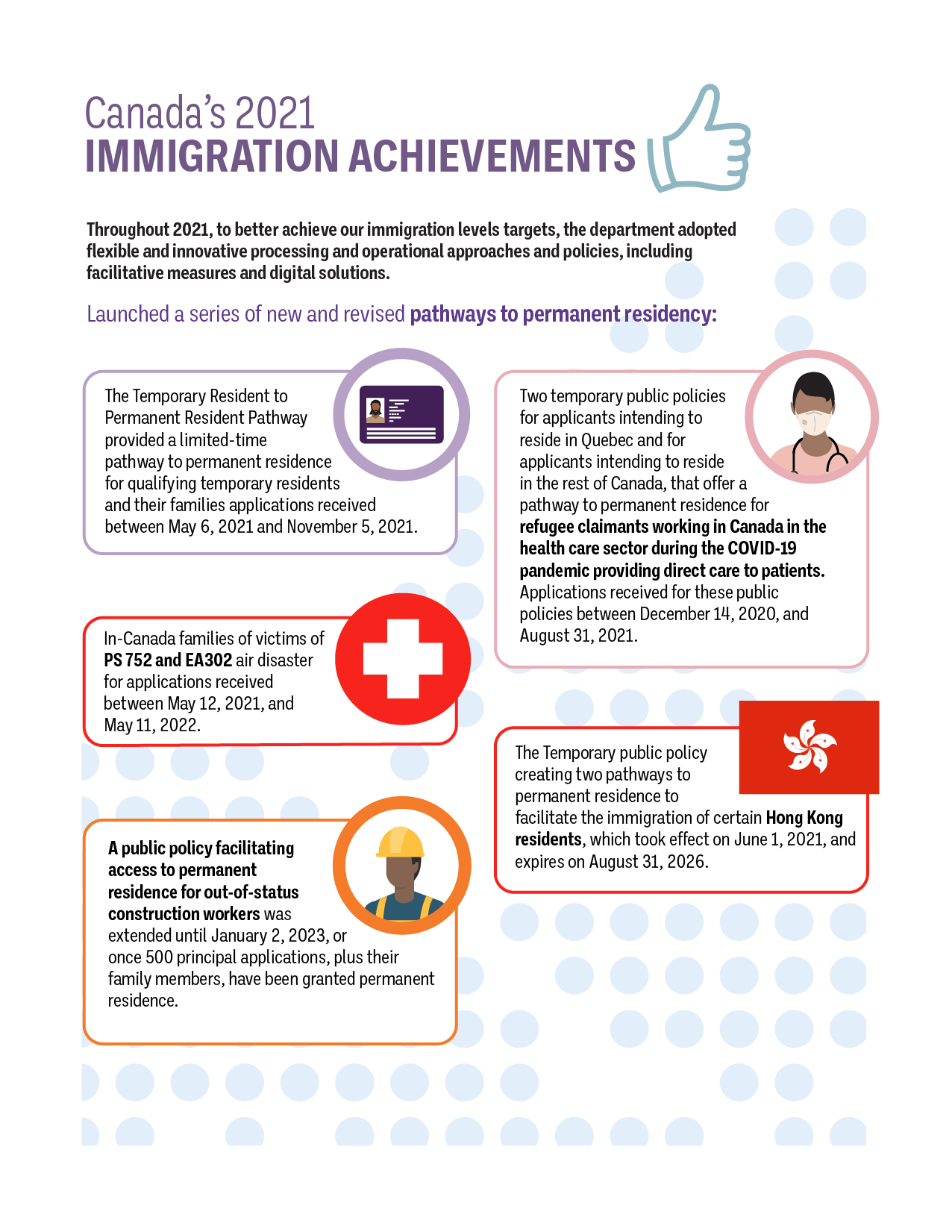
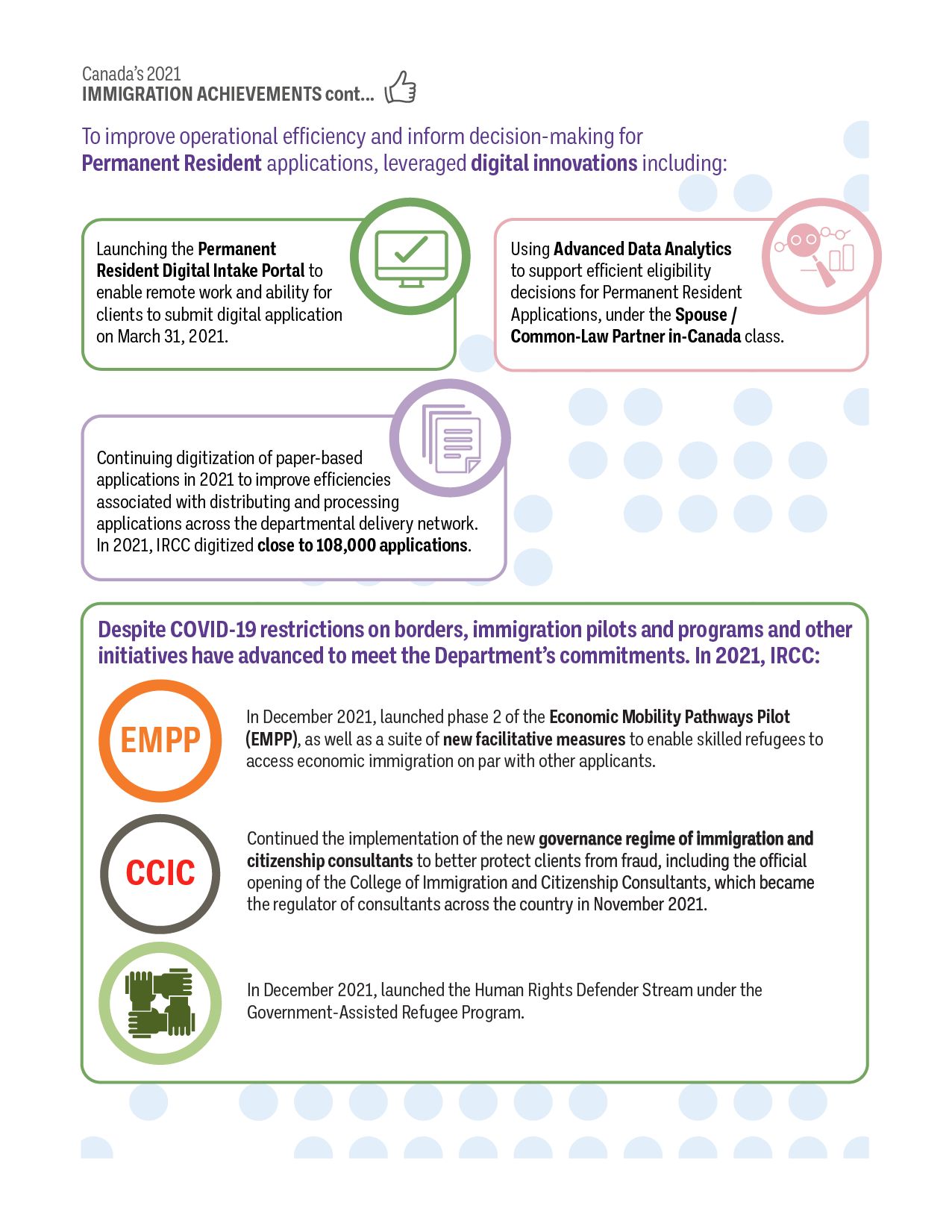
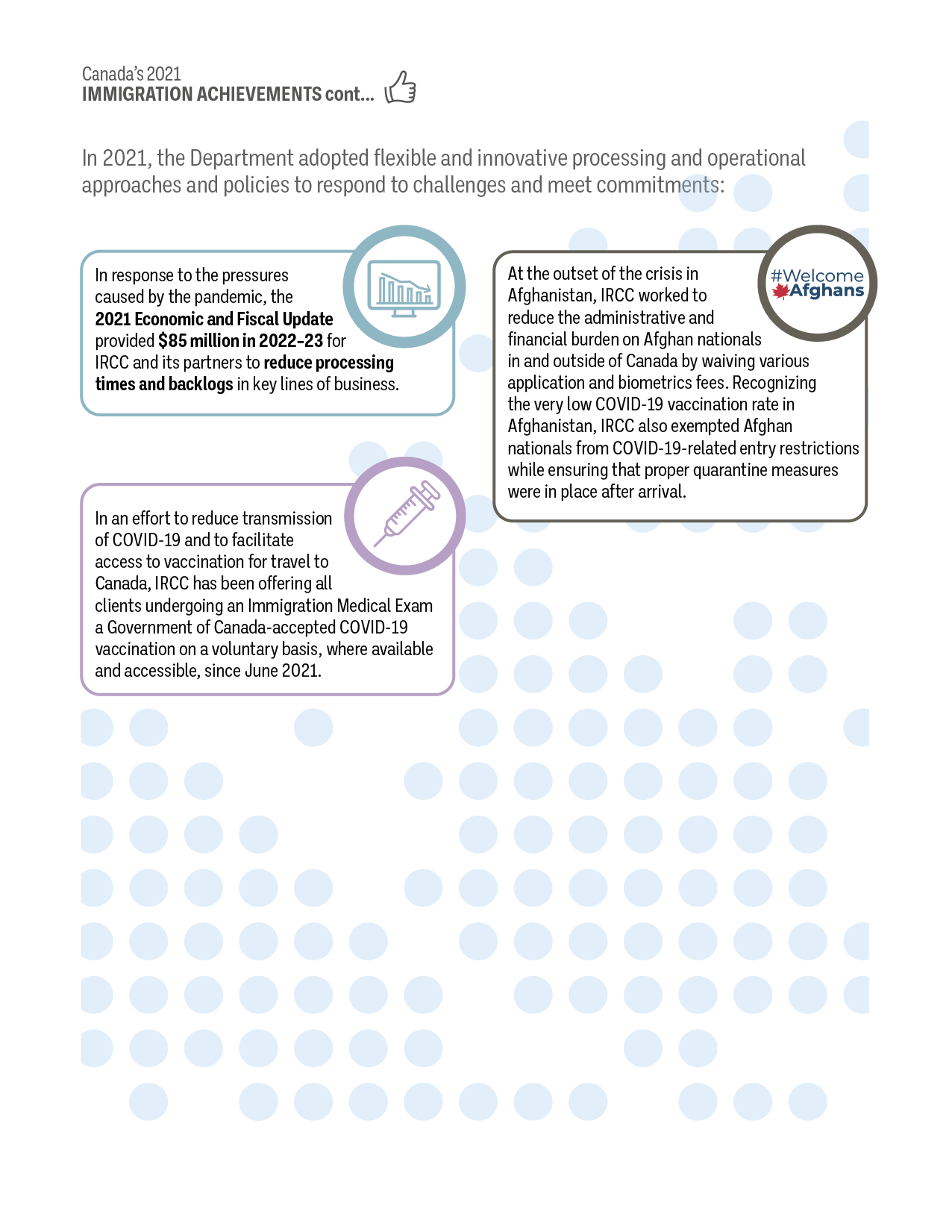
Text version: Canada’s 2021 immigration achievements
Throughout 2021, to better achieve our immigration levels targets, the department adopted flexible and innovative processing and operational approaches and policies, including facilitative measures and digital solutions.
Launched a series of new and revised pathways to permanent residency:
- The Temporary Resident to Permanent Resident Pathway provided a limited-time pathway to permanent residence for qualifying temporary residents and their families, applications received between May 6, 2021 and November 5, 2021.
- In-Canada families of victims of PS 752 and EA302 air disaster, for applications received between May 12, 2021, and May 11, 2022.
- A public policy facilitating access to permanent residence for out-of-status construction workers was extended until January 2, 2023, or once 500 principal applicants, plus their family members, have been granted permanent residence.
- Two temporary public policies for applicants intending to reside in Quebec and for applicants intending to reside in the rest of Canada, that offer a pathway to permanent residence for refugee claimants working in Canada in the healthcare sector during the COVID-19 pandemic providing direct care to patients. Applications received for these public policies between December 14, 2020 and August 31, 2021.
- The Temporary public policy creating two pathways to permanent residence to facilitate the immigration of certain Hong Kong residents, which took effect on June 1, 2021 and expires on August 31, 2026.
To improve operational efficiency and inform decision-making for Permanent Resident applications, leveraged digital innovations including:
- Launching the Permanent Resident Digital Intake Portal to enable remote work and abilityu for clients to submit digital application on March 31, 2021.
- Using Advanced Data Analytics to support efficient eligibility decisions for Permanent Resident Applications, under the Spouse / Common-Law Partner in-Canada class.
- Continuing digitization of paper-based applications in 2021 to improve efficiencies associated with distributing and processing applications across the departmental delivery network. In 2021, IRCC digitized close to 108,000 applications.
Despite COVID-19 restrictions on borders, immigration pilots and programs and other initiatives have advanced to meet the Department’s commitments. In 2021, IRCC:
- In December 2021, launched phase 2 of the Economic Mobility Pathways Pilot (EMPP), as well as a suite of new facilitative measures to enable skilled refugees to access economic immigration on par with other applicants.
- Continued the implementation of the new governance regime of immigration and citizenship consultants to better protect clients from fraud, including the official opening of the College of Immigration and Citizenship Consultants, which became the regulator of consultants across the country in November 2021.
- In December 2021, launched the Human Rights Defender Stream under the Government-Assisted Refugee Program.
In 2021, the Department adopted flexible and innovative processing and operational approaches and policies to respond to challenges and meet commitments:
- In response to the pressures caused by the pandemic, the 2021 Economic and Fiscal Update provided $85 million in 2022–23 for IRCC and its partners to reduce processing times and backlogs in key lines of business.
- In an effort to reduce transmission of COVID-19 and to facilitate access to vaccination for travel to Canada, IRCC has been offering all clients undergoing an Immigration Medical Exam a Government of Canada-accepted COVID-19 vaccination on a voluntary basis, where available and accessible, since June 2021.
- At the outset of the crisis in Afghanistan, IRCC worked to reduce the administrative and financial burden on Afghan nationals in and outside of Canada by waiving various application and biometrics fees. Recognizing the very low COVID-19 vaccination rate in Afghanistan, IRCC also exempted Afghan nationals from COVID-19-related entry restrictions while ensuring that proper quarantine measures were in place after arrival.
Vaccine roll out
“We’ve achieved some extraordinary things during the pandemic. How people have come together, to engage and support one another, speaks to the strength and resilience of Canadian culture and society. Being Canadian is one of the things I’m most proud of.”

The COVID-19 pandemic is the largest and most challenging public health crisis in recent history. Dr. Victoria Lee, President and CEO of Fraser Health Authority in Surrey, British Columbia, is at the helm of pandemic preparedness and response, including the vaccine rollout in the region.
Originally from South Korea, Dr. Lee immigrated to Canada at age 12 with her parents and two younger siblings. Her parents had envisioned more opportunities for their children in Canada, a place where they could become whomever they wanted.
Dr. Lee’s interest in medicine was greatly inspired by her grandfather, an accomplished scientist in South Korea and a founding professor of the Department of Microbiology at Seoul National University.
Fraser Health is one of five publicly funded healthcare regions in British Columbia. With more than 1.9 million residents across 20 communities, 32 First Nations communities, and 5 Chartered Métis Nations, it is the most populous health-care region in the province. As CEO, Dr. Lee leads over 40,000 individuals she refers to as the “Fraser Health Family,” including medical staff, other employees, and volunteers.
“There aren’t enough hours in the day to do what we need to do,” she says. “But at the same time, my team mobilizes and energizes me, minute-to-minute, day-to-day. We’ve accomplished an incredible amount together since the first COVID-19 case appeared over a year ago. We’re starting to see the light at the end of the tunnel.”
Dr. Lee is quick to credit residents of the Fraser Health region for their part in the pandemic response.
Temporary resident programs and volumes
Temporary residents
Temporary residents coming to Canada must receive either a temporary resident visa (TRV) or an electronic travel authorization (eTA) from Immigration, Refugees and Citizenship Canada (IRCC) before departure to Canada, with few exceptions (notably U.S. passport holders). Temporary Residents include visitors, students, and temporary foreign workers.
Number of eTAs and TRVs
In 2021, 813,306 eTAs and 654,027 TRVs were issued. This record low volume of documents is due to border closures and travel restrictions.
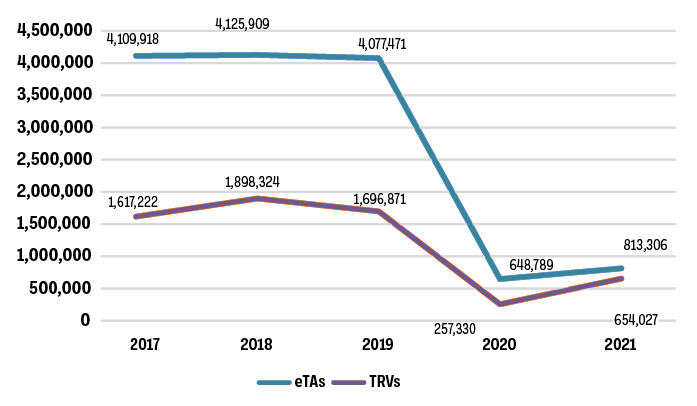
Text version: Number of eTAs and TRVs
| Year | 2017 | 2018 | 2019 | 2020 | 2021 |
|---|---|---|---|---|---|
| eTAs | 4,109,918 | 4,125,909 | 4,077,471 | 648,789 | 813,306 |
| TRVs | 1,617,222 | 1,898,324 | 1,696,871 | 257,330 | 654,027 |
Visitors
Visitors to Canada, which include tourists, business travellers, and other temporary visitors, contribute to economic growth in Canada. In 2021, a total of 962,506 TRVs and eTAs were issued to visitors. In September 2021, the announcement on the easing of border restrictions saw IRCC prioritize the processing of visas and eTAs for business travellers and clients who self-identified as meeting a family member exemption, and pre-adjudicated family members who required written authorization to travel to Canada. Starting in September 2021, the various COVID-19 exemptions were wound down in favour of entry requirements based on vaccination status.
International students
An essential part of Canada’s long-standing global attractiveness is its International Student Program. From 2017 to 2019, there was a steady increase in study permit holders in Canada. While the number of study permit holders decreased to 256,540 in 2020 due to the COVID-19 pandemic, the international student population surpassed pre-pandemic levels in 2021. Throughout 2021, IRCC offices in Canada and overseas continued to actively process study permit applications for students accepted for study at Designated Learning Institutions, with a total of 445,776 study permit holders who entered Canada.
While in Canada, international students bring benefits such as new cultures, ideas, and competencies to Canada’s landscape while enriching the academic experience of domestic students. They also continue to bring long-term benefits to Canada, as many continue to transition to permanent residents in the country. In 2021, there was a total of 22,682 admissions of permanent residents for international students previously holding a study permit. Furthermore, IRCC announced an extension of temporary COVID-19 facilitation measures for the Post-Graduate Work Permit (PGWP) program that were set to expire on August 31, 2022. These measures allow international students to complete up to 50% of their studies outside of Canada while remaining PGWP-eligible and are in effect from September 1, 2022 until August 31, 2023.
International Students
Study Permit Holders
In 2021, there was a total of 445,776 study permit holders.
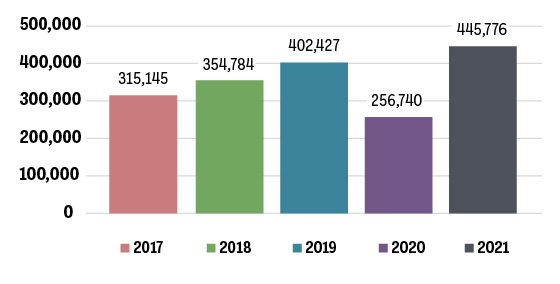
Text version: International Students, Study Permit Holders
| Year | 2017 | 2018 | 2019 | 2020 | 2021 |
|---|---|---|---|---|---|
| International Students (study permit holders) | 315,145 | 354,784 | 402,427 | 256,740 | 445,776 |
Temporary Foreign Workers
IRCC facilitates the entry of foreign nationals who seek temporary work in Canada. In 2021, a total of 168,656 work permit holders transitioned to permanent residency. IRCC continued to work closely with other government departments — including the Public Health Agency of Canada and the Canada Border Services Agency — to ensure temporary workers could continue to enter Canada despite pandemic-related border restrictions, in order to fill labour shortages and bring essential skills to Canadian businesses during the COVID-19 pandemic.
IRCC also worked with Employment and Social Development Canada to continue efforts to enhance worker protections, in particular by consulting publicly on proposed new requirements for employers that would reduce the vulnerability of temporary workers, such as by prohibiting employers from charging recruitment fees to workers. These new regulatory requirements are expected to come into force in 2022.
As per the graph below on the Temporary Foreign Workers Program (TFW) and International Mobility Program (IMP), volumes showed a steady increase from 2017–19 for both programs, a decrease in 2020 as a result of the pandemic, followed by a return increase in work permit holders in 2021. The IMP is separate from the TFW, as it is primarily administered by IRCC specifically for employers looking to hire using the program, and does not require a Labour Market Impact Assessment for the issuance of permits.
Temporary Foreign WorkersTable footnote *
Work Permit Holders
In 2021, there was a total of 103,552 permit holders through the TFW Program. Under the IMP, there was a total of 313,294 work permit holders.
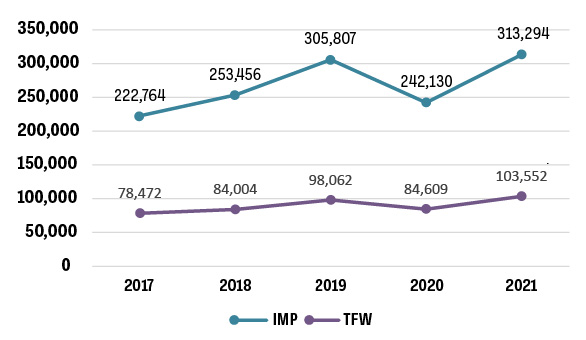
Text version: Temporary Foreign Workers, Work Permit Holders
| Year | IMP | TFW |
|---|---|---|
| 2017 | 222,764 | 78,472 |
| 2018 | 253,456 | 84,004 |
| 2019 | 305,807 | 98,062 |
| 2020 | 242,130 | 84,609 |
| 2021 | 313,294 | 103,552 |
Global Skills Strategy
Canada’s Global Skills Strategy (GSS) makes it easier for Canadian businesses to attract the talent they need to succeed in the global marketplace.
Whether recruiting professionals from around the world to train Canadian workers or working with employers planning job-creating investments in Canada, the GSS provides businesses in Canada with a faster way to bring in global talent in order to scale up and grow — creating better jobs for more Canadians.
In 2021, the GSS continued to be an important tool to support Canadian employers who need to access foreign talent to grow, innovate, and create jobs for Canadians. Although affected by pandemic-related delays, IRCC approved the applications of over 38,500 temporary workers with specialized skillsets and global experience under the umbrella of the GSS, contributing to Canada’s economic recovery.
Permanent immigration to Canada
GBA Plus Spotlight
Gender disaggregation of data concerning the total number of admissions for principal applicants and accompanying individuals within each economic immigration program shows that a total of 115,682 women and 137,288 men were admitted through the economic class in 2021. The data demonstrates an increase from 2020, where there were a total 50,294 women, and 56,127 men admitted.
Economic immigration
The economic immigration class is the largest source of permanent resident admissions to Canada, at approximately 62% of all admissions in 2021, which is consistent with the trend observed over the past four years. In 2021, the number of individuals admitted to Canada under the economic class totaled 252,971, which includes spouses and their dependents. The economic class of immigrants is a critical component for meeting Canada’s economic objectives including labour force growth, meeting labour market needs and increased productivity. Canada offers several permanent residence pathways through which people can apply to address diverse national, regional and sectoral economic demands.
Economic Immigration
Principal applicants and their spouses and/or dependants
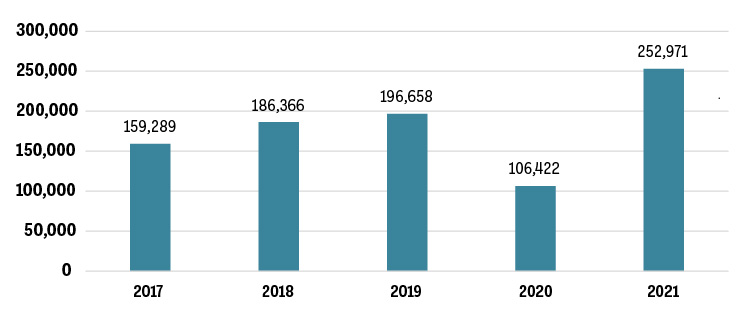
Text version: Economic Immigration, Principal applicants and their spouses and/or dependants
| Year | 2017 | 2018 | 2019 | 2020 | 2021 |
|---|---|---|---|---|---|
| Economic Immigration Principal applicants and their spouses and/or dependants |
159,289 | 186,366 | 196,658 | 106,422 | 252,971 |
Federal economic immigration programs
Canada’s federal high-skilled programs — Canadian Experience Class, Federal Skilled Worker Program, and Federal Skilled Trades Program — traditionally represent the largest economic immigration category in the Immigration Levels Plan. In 2021, 139,459 new permanent residents were admitted through these programs. Express Entry is the application management system, used since 2015, to select candidates in the federal high-skilled programs on the basis of their ability to succeed in the Canadian economy and society over the long-term (based on factors such as work experience, education, and official language proficiency). This selection approach allows Canada to benefit from a regular and predictable flow of skilled immigrants that employers can hire to meet their labour needs and to grow and scale up their businesses.
In 2021, in response to challenges in admitting new permanent residents from overseas amid the pandemic and related bordure closures, the Department pivoted to focus on temporary residents in Canada who could contribute to economic immigration objectives, including recent international graduates and workers with experience in defined essential occupations. Some of these efforts are listed below.
Making use of the flexibility of the Express Entry system, invitations to apply were focused on candidates nominated by a province or territory, as well as candidates who were eligible for the Canadian Experience Class. An invitation to apply was issued on February 13, 2021 to all candidates in the Express Entry pool who were eligible for the Canadian Experience Class, resulting in invitations to apply for permanent residence being sent to over 27,000 candidates, over 90% of whom were already in Canada and employed.
The time-limited temporary resident to permanent resident pathway, which targeted recent international graduates and essential workers in areas such as healthcare, received over 106,000 applications. Dedicated streams for French-speaking and bilingual temporary residents were included, whereby an unlimited number of applications where accepted. Through this pathway, approximately 24,000 new permanent residents were admitted in 2021 and an additional 18,000 were admitted by the end of March 2022. A further 32,000 admissions are planned in 2023.
Immigration, Refugees and Citizenship Canada (IRCC) also created a temporary public policy to provide a pathway to permanent residency for certain refugee claimants working in the health-care sector during the COVID-19 pandemic (known as Guardian Angels). This one-time initiative, implemented between December 2020 and August 2021, recognized the extraordinary contribution of refugee claimants working in Canada’s health-care sector when there was an urgent need for help.
The three-year Agri-Food Pilot, launched on May 15, 2020, provides a new pathway to permanent residence for experienced non-seasonal workers in specific agri-food industries and occupations.Footnote 6
In 2021, IRCC finalized permanent residence applications for nearly 6,000 caregivers and their family members, leading to admissions in 2021 and beyond.
IRCC continued to welcome immigrant entrepreneurs through the Federal Business Immigration Programs (Start-Up Visa and Self-Employed), and is addressing the inventory of applications that grew over the pandemic. In 2021, IRCC admitted 565 foreign entrepreneurs and their family members to become permanent residents and launch their businesses in Canada.
Regional economic immigration programs
The Government of Canada offers several economic immigration programs that attract a broad range of talented people to contribute to communities across the country. Some of these programs are listed below.

There were 54,020 people admitted through the Provincial Nominee Program in 2021, a 40% increase from 2020 admissions. This represents over 21% of permanent resident admissions in the economic category and directly supports provinces and territories with meeting their labour market needs in various critical sectors, including healthcare, hospitality, food services, and transportation.

On December 17, 2021, IRCC and the Atlantic provinces announced that the Atlantic Immigration Pilot would become a permanent program as of January 1, 2022. The Atlantic Immigration Program builds on the strengths of the pilot and retains the core objectives of attracting and retaining skilled immigrants to Atlantic Canada to address demographic and economic needs in the region. Over the past few years, the Atlantic Immigration Program has brought and retained thousands of newcomers to the region. These new permanent residents have helped communities to thrive, businesses to prosper, and the region’s population to grow.

The Rural and Northern Immigration Pilot is a community-driven program, launched by IRCC in 2019. It is designed to extend the benefits of economic immigration to 11 smaller and more remote communitiesFootnote 7 by creating a path to permanent residence for skilled foreign workers who want to work and live in one of the participating communities. Since its inception, the Pilot has helped participating communities attract and retain newcomers to address labour market needs in key sectors, such as healthcare, hospitality and food services, retail, manufacturing, and transportation.

Consultations with provinces, territories, and key stakeholders took place in 2020 and 2021 to inform the design of the new Municipal Nominee Program. The lessons learned from IRCC’s other economic pilots, notably the Rural and Northern Immigration Pilot, will inform this new permanent residence program.

IRCC began accepting applications under phase 2 of the Economic Mobility Pathways Pilot (EMPP) in December 2021. The EMPP helps skilled refugees and their families immigrate to Canada through existing economic programs to support Canadian labour market needs. As part of phase 2, the EMPP will work with eight participating provinces and territories to accept applications from up to 500 skilled refugees and their families. Furthermore, the Department has been looking at expanding this pilot to create additional room specifically for Afghan refugees post-2021. This work will also help inform the Department’s approach to the mandate letter commitment to further expand EMPP to welcome 2,000 skilled refugees to fill specific labour shortages in high-demand sectors, such as healthcare.
The role of Local Immigration Partnerships
Local Immigration Partnerships (LIPs) convene local stakeholders from a variety of sectors (including various orders of government) to provide a framework for promoting community-based planning around the needs of newcomers. There are currently 86 LIPs across the country.Footnote 8
LIPs support the coordination of settlement services at the local level, and encourage non-settlement institutions to adapt their programming and service delivery to address the needs of newcomers (e.g., employment, housing, education, transit, healthcare).
Family reunification
Canadian permanent residents and citizens may sponsor members of their familyFootnote 9 to come to Canada as permanent residents, bringing many economic, social, and cultural benefits to communities across the country. In 2021, 81,423 individuals were admitted under this category. While the focus in 2021 was on in-Canada applicants, there was an exemption from travel restrictions for certain family members, and family class applications from overseas were finalized by IRCC. In response to the crisis in Afghanistan, as part of IRCC’s special measures for Afghan nationals, priority processing was implemented for family reunification applications submitted by Canadians and permanent residents sponsoring certain relatives outside of Canada who are Afghan nationals.
Family Reunification
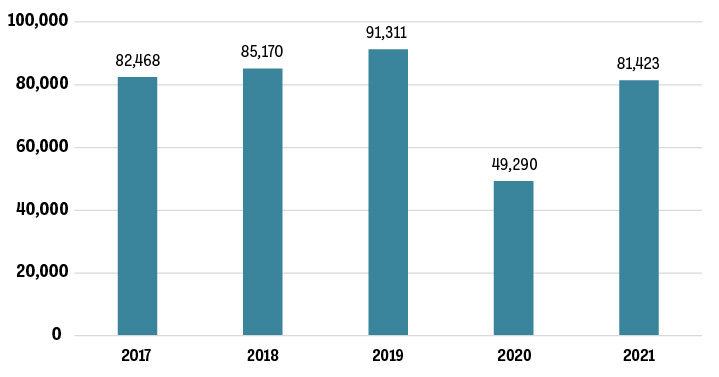
Text version: Family Reunification
| Year | 2017 | 2018 | 2019 | 2020 | 2021 |
|---|---|---|---|---|---|
| Family Reunification | 82,468 | 85,170 | 91,311 | 49,290 | 81,423 |
Spouses, partners, and children
As part of the Family Reunification Program, IRCC processes applications for the sponsorship of spouses, partners, and children of Canadian citizens and permanent residents. In 2021, there were 69,685 admissionsFootnote 10 under this category, with a remaining inventory of 67,826 at the end of the year. IRCC facilitated the processing of these applications through a number of methods, including the use of advanced analytics to support eligibility determination, file digitization, and extra staffing, all in order to reduce processing times and advance efforts to return to the 12 month service standard. In 2021, there was a 95% approval rate in the processing of applications for spouses and partners.
Spouses, Partners and Children
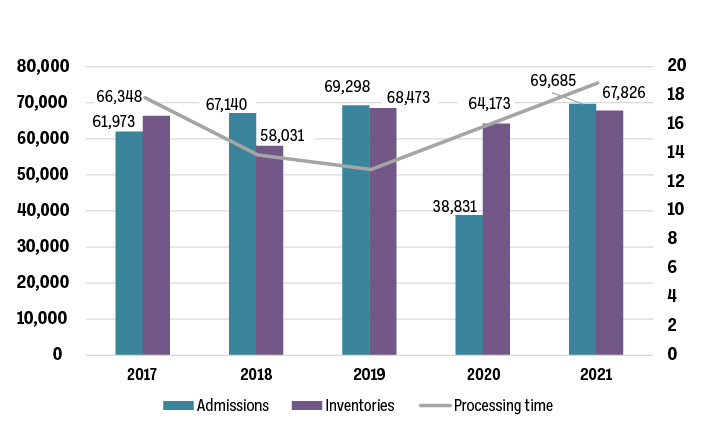
Text version: Spouses, Partners and Children
| Year | 2017 | 2018 | 2019 | 2020 | 2021 |
|---|---|---|---|---|---|
| Admissions | 61,973 | 67,140 | 69,298 | 38,831 | 69,685 |
| Inventories | 66,348 | 58,031 | 68,473 | 64,173 | 67,826 |
| Processing time | 18 | 14 | 13 | 16 | 19 |
Parents and grandparents
In 2020–21, IRCC invited 47,900 prospective sponsors, who had submitted interest to sponsor forms, to submit applications to sponsor their parents and grandparents, with the goal of accepting up to 40,000 new applications in 2021. In addition, 11,738 sponsored parents and grandparents were admitted in 2021 as permanent residents to Canada through the Parents and Grandparents Program, which is a slight increase from 2020.
Parents and Grandparents
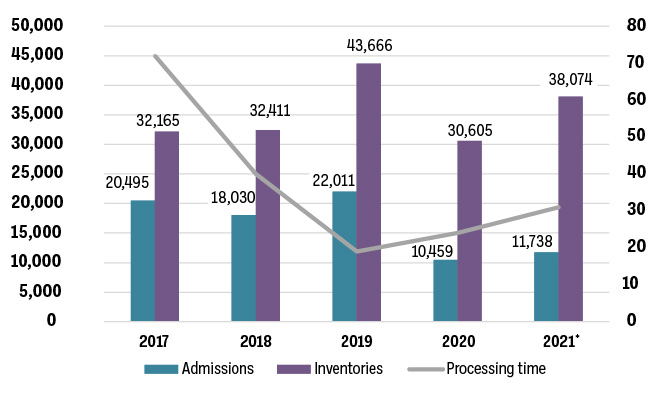
Text version: Parents and Grandparents
| Year | 2017 | 2018 | 2019 | 2020 | 2021Table footnote * |
|---|---|---|---|---|---|
| Admissions | 20,495 | 18,030 | 22,011 | 10,459 | 11,738 |
| Inventories | 32,165 | 32,411 | 43,666 | 30,605 | 38,074 |
| Processing time | 72 | 40 | 19 | 24 | 31 |
Settlement and integration
IRCC supports the successful integration of immigrants to Canada through a suite of settlement and integration services. In 2021–22, IRCC funded more than 550 service provider organizations, and provided settlement services to more than 428,000 clients. Services include pre-arrival and post-arrival orientation and information services, needs and assets assessment and referrals, language training, employment-related services including mentorship and apprenticeship programming, and services that help newcomers connect and contribute to their communities. These services also help newcomers navigate the labour market as well as barriers to employment. For example, IRCC funds the CARE National Project, which provides pre-arrival, virtual programming – such as webinars, workplace communication skills training, and mentorship opportunities, to help shorten the length of time internationally educated nurses spend from arrival in Canada to registration and regulated nursing employment. Also included are support services that help address barriers to access for settlement services, including childcare, transportation, translation, and accessibility aids, as well as indirect services that help to build the capacity of the settlement sector to address ongoing and future needs of newcomers.
The pandemic continued to impact the settlement sector, with the majority of settlement services continuing to be delivered online to ensure that newcomers and refugees were well-supported during the pandemic. In addition, service providers across the country introduced new practices, including rapid, innovative, and successful program delivery transformations to respond to pandemic-related challenges. In this context, the Department has begun to take stock of what works well and how best to support clients in the post-pandemic era, with the goal of supporting future intake processes and clients getting the services they need, when and where they need them.
In addition, IRCC supported client-centric programming, including through the Racialized Newcomer Women Pilot, which supports employment outcomes and career advancement for racialized newcomer women. IRCC provided an additional $15 million to extend the pilot until 2022–23, building on existing Government of Canada investments. IRCC also continued to support the Welcoming Francophone Communities Initiative to support the integration of French-speaking newcomers outside of Quebec.
Clients who received at least one Settlement Service by Fiscal Year
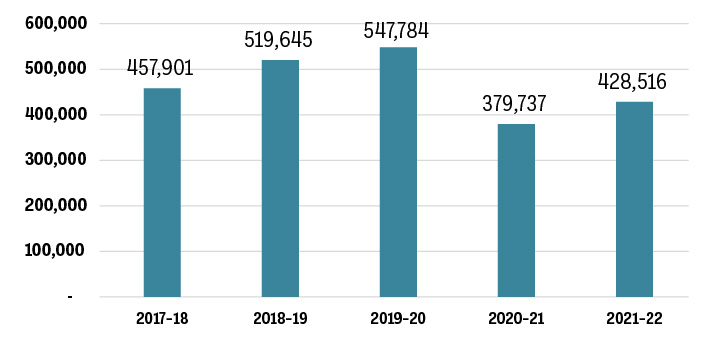
Text version: Clients who received at least one Settlement Service by Fiscal Year
| Fiscal Year | 2017-18 | 2018-19 | 2019-20 | 2020-21 | 2021-22 |
|---|---|---|---|---|---|
| Clients who received at least one settlement service | 457,901 | 519,645 | 547,784 | 379,737 | 428,648 |
Refugees, protected persons, and humanitarian and compassionate immigration
In 2021, a total of 60,228 refugees and protected persons were admitted as permanent residents. This is within IRCC’s target range of 39,500 to 62,000.Footnote 11 In addition, a total of 11,377 individuals were admitted on humanitarian, compassionate, and public policy grounds. For more information on these admissions, please consult Annex 2, tables 3 and 4.
As a decade-long rise in global displacement hits another record, Canada continues to be the world leader in refugee resettlement. A United Nations Refugee Agency (UNHCR) report showed that Canada was a global leader in resettling refugees in 2021, making it a three-year leader in refugee resettlement.Footnote 12 Canada maintained its proud humanitarian tradition of being the top refugee resettlement country in the world, resettling 20,428 refugees in 2021, according to the UNHCR Global Trends Report.Footnote 13
Of all refugees resettled in 2021:
- 10,811 were government assisted;
- 9,541 were privately sponsored; and
- 76 were admitted under the Blended Visa Office-Referred Refugees Program, which enables sponsorship groups and government to jointly support resettled refugees identified by the UNHCR.
In addition to resettled refugees, 39,800 individuals obtained permanent residence under the protected persons in Canada and dependants abroad category.
Refugees and Protected Persons
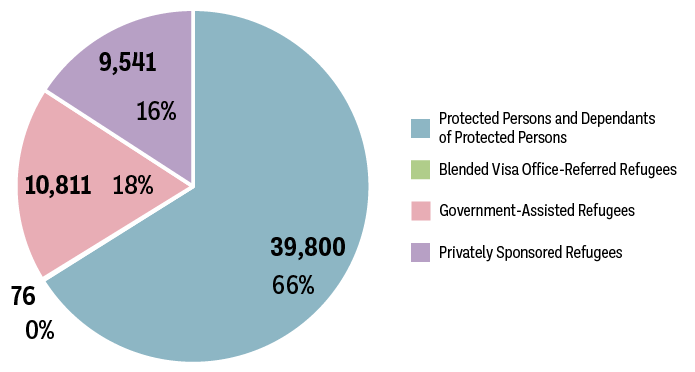
Text version: Refugees and Protected Persons
| Number | Percentage | |
|---|---|---|
| Protected Persons and Dependants of Protected Persons | 39,800 | 66% |
| Blended Visa Office-Referred Refugees | 76 | 0% |
| Government-Assisted Refugees | 10,811 | 18% |
| Privately Sponsored Refugees | 9,541 | 16% |
In addition, IRCC introduced a dedicated refugee stream to human rights defenders at risk, in recognition of the reprisals that they face for their work. The new stream was designed in close consultation with Canadian and international experts and civil society organizations to ensure the program best meet the needs of the human rights defenders who face the most serious risks. Under this stream, human rights defenders are identified and referred by the civil society protection experts Front Line Defenders and ProtectDefenders.eu in collaboration with the United Nations Refugee Agency, and are resettled through the Government-Assisted Refugees Program. Like other government-assisted refugees, they are supported upon arrival in Canada by settlement provider organizations funded by IRCC. While the UNHCR’s resettlement mandate does not extend to persons in-country, IRCC established a referral partnership with Front Line Defenders and ProtectDefenders.eu to enable the identification, triaging, and referral of human rights defenders inside Afghanistan via the humanitarian stream of the Afghan resettlement initiative.
Asylum claimants
The in-Canada asylum system provides protection to foreign nationals when it is determined that they have a well-founded fear of persecution. Canada received close to 25,000 asylum claims in 2021, with pandemic-related border measures significantly decreasing irregular arrivals between March 2020 and November 2021. Throughout 2021, IRCC continued to maintain effective and important inter-departmental communication with partners, as well as provincial/territorial engagement, to support an effective and fair asylum system for asylum claimants. Since the gradual lifting of COVID -19 restrictions in 2021, there has been a significant rise in volumes. Over the next year, IRCC is expecting to see growing volumes of new asylum claims — from both irregular migrants and other asylum seekers.
In recognition of their exceptional contribution to Canada during the COVID-19 pandemic, the Department implemented a special measure to provide a pathway to permanent residence for asylum claimants across the country working in the health-care sector, with applications being accepted from December 2020 to August 2021.
Asylum Claims by Year
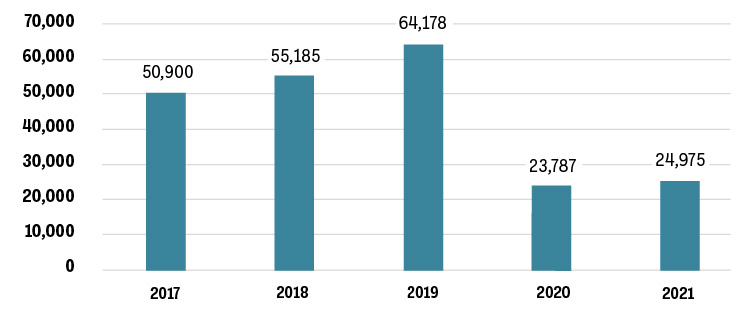
Text version: Asylum Claims by Year
| Year | 2017 | 2018 | 2019 | 2020 | 2021 |
|---|---|---|---|---|---|
| Asylum Claims | 50,380 | 55,040 | 64,035 | 23,720 | 24,975 |
Humanitarian and compassionate grounds and other considerations
The Immigration and Refugee Protection Act authorizes the Minister of IRCC to grant permanent residence status to individuals and their families who would not otherwise qualify under an immigration category. These discretionary provisions for humanitarian and compassionate grounds or public policy considerations provide the flexibility to approve deserving cases that come forward. In 2021, a total of 11,377 people were admitted to Canada for humanitarian and compassionate grounds and public policy considerations. This category accounted for 3% of all permanent residents.
Francophone immigration outside of Quebec
IRCC continues to support the commitment of the Government of Canada to enhance the vitality of French linguistic minority communities in Canada outside of Quebec. Francophone immigration plays an important role in upholding the bilingual nature of the country and supporting the growth of French linguistic minority communities and Canada’s economic recovery.
IRCC’s Francophone Immigration Strategy aspires to increase Francophone immigration to reach a target of 4.4% of immigrants outside Quebec being French-speaking by 2023. This target was established in consultation with community stakeholders; it is not annual but rather to be achieved by the end of 2023. The pandemic and related border closures nearly stopped the arrival of French-speaking permanent residents, who were either approved or in the process of being admitted to Canada in 2020 and 2021. As such, IRCC turned to in-land applications (temporary residents) to reach the goals set out in its Levels Plan. Given there were proportionally fewer French-speaking Temporary Residents able to transition to permanent residency, the decline of francophone admissions was further exacerbated. IRCC continues to work with provinces and territories to advance cross-jurisdictional efforts in support of its Francophone Immigration Strategy.
Francophone settlement services
Several initiatives funded through the Action Plan for Official Languages 2018–2023 support the Francophone Integration Pathway, which consists of a suite of settlement services in French, offered in a coordinated and integrated manner by Francophone communities outside of Quebec to French-speaking newcomers. The Francophone Integration Pathway has established the groundwork for an effective service infrastructure so that Francophone minority communities are better able to welcome, integrate, and retain newcomers.
In 2021, efforts to support reaching the 4.4% target relied on actions across the pillars of the immigration continuum, from attraction to selection and retention of French-speaking newcomers outside of Quebec. Key initiatives, in collaboration with provinces and territories, included strengthened selection tools favouring French-speaking candidates (e.g., temporary TR to PR public policy, which targeted recent French-speaking graduates as well as French-speaking essential workers); targeted promotional efforts in Canada and abroad (including the first entirely virtual Destination Canada, a job fair for French-speaking candidates to obtain information and network, organized twice in 2021); and continued consolidation of the Francophone Integration Pathway.
These efforts resulted in 6,946 French-speaking permanent residents admitted to Canada outside of Quebec in 2021. Of the French-speaking permanent residents admitted to Canada outside of Quebec, 60% came through the Economic class, which includes federal and provincial/territorial economic programs. In 2021, the Provincial Nominee Program was the second largest driver to attract French-speaking economic immigrants to Canada, with 1,225 French-speaking admissions.
Close to 60% of admissions were citizens of France, Morocco, Burundi, the Democratic Republic of Congo, and Cameroon.
Nevertheless, the proportion of French-speaking permanent resident admissions increased again to 3,6% from January to July 2022 and, since 2019, the total number of admissions for French-speaking permanent residents outside Quebec has remained above 5,000 per annum.
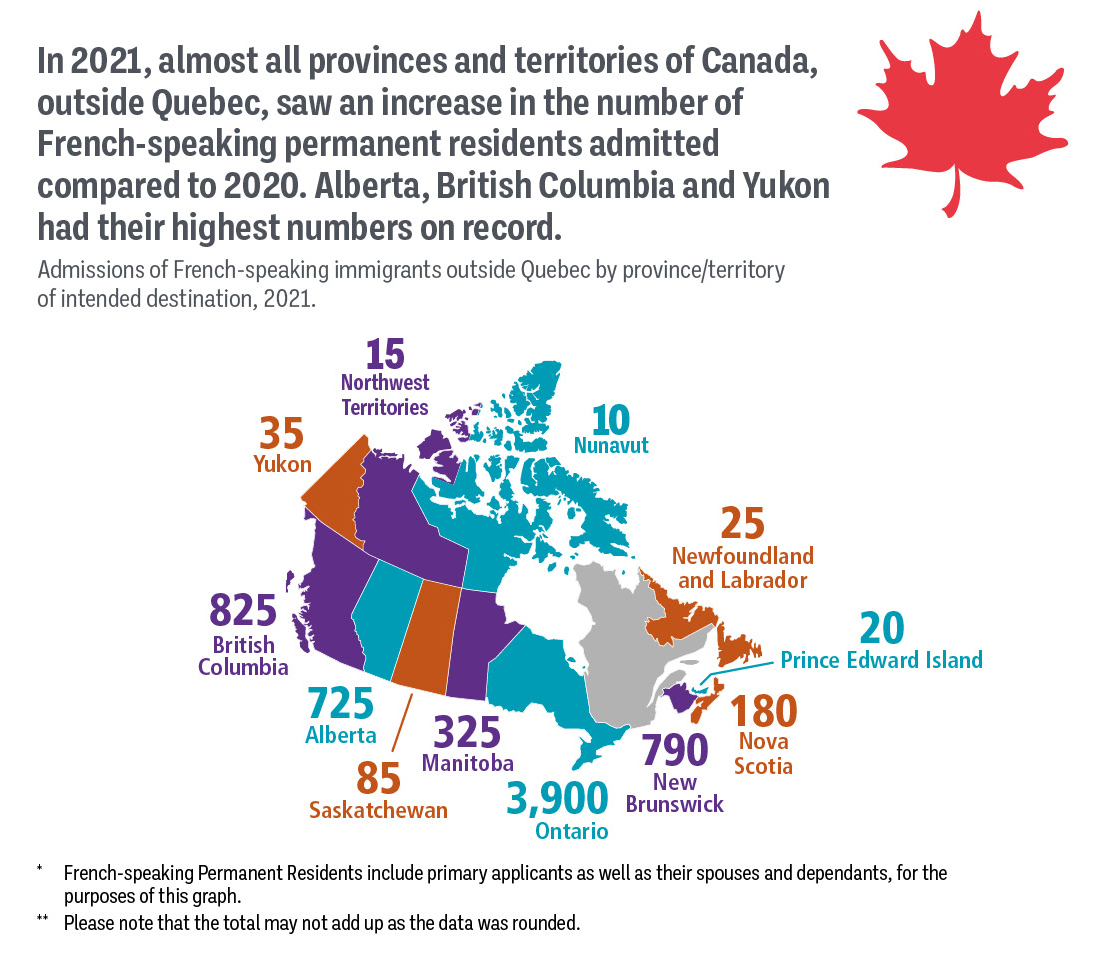
Text version: Francophone immigration outside of Quebec
In 2021, almost all provinces and territories of Canada, outside Quebec, saw an increase in the number of French-speaking permanent residents admitted compared to 2020. Alberta, British Columbia and Yukon had their highest numbers on record.
| Alberta | British Columbia | Manitoba | New Brunswick | Newfoundland and Labrador | Nunavut | Northwest Territories | Nova Scotia | Ontario | Prince Edward Island | Saskatchewan | Yukon |
|---|---|---|---|---|---|---|---|---|---|---|---|
| 725 | 825 | 325 | 790 | 25 | 10 | 15 | 180 | 3,900 | 20 | 85 | 35 |
* French-speaking Permanent Residents include primary applicants as well as their spouses and dependants, for the purposes of this document.
** Please note that the total may not add up as the data was rounded.

Spotlight: Leveraging the transition from TR to PR in support of Francophone immigration
IRCC created a TR-PR pathway (May 6, 2021 to November 5, 2021) with dedicated uncapped streams for French-speaking/bilingual temporary essential workers (including health-care workers) and recent international graduates. More than 7,000 applications were received under these streams, representing 8% of overall applications submitted.
Canada’s next permanent resident Immigration Levels Plan
The multi-year Immigration Levels Plan projects how many permanent residents Canada aims to admit over the course of a calendar year. Every year, Immigration, Refugees and Citizenship Canada (IRCC) sets targets and ranges for the total number of permanent residents admitted into the country, as well as the number for each immigration category.
IRCC has presented a rolling multi-year (3 years) Immigration Levels Plan for admissions every year since 2017. The plan is developed in consultation with provinces and territories, stakeholder organizations, and the public. The selection of applicants is categorized based on economic contributions, family reunification, or support for refugees, protected persons, and humanitarian and compassionate needs.
| 2023 | 2024 | 2025 | ||||
|---|---|---|---|---|---|---|
| Projected admissions – Targets | 465,000 | 485,000 | 500,000 | |||
| Projected admissions – Ranges | Low | High | Low | High | Low | High |
| Economic immigrationTable note * | 233,000 | 277,250 | 250,000 | 305,000 | 265,000 | 326,000 |
| Family reunification | 100,000 | 118,000 | 105,000 | 130,000 | 107,000 | 135,000 |
| Refugees, protected persons, humanitarian and compassionate and other | 77,000 | 109,750 | 75,000 | 107,500 | 70,500 | 89,000 |
| TotalTable note ** | 410,000 | 505,000 | 430,000 | 542,500 | 442,500 | 550,000 |
Federal-provincial-territorial partnerships
Immigration: A joint responsibility
Immigration is a joint federal-provincial-territorial (FPT) responsibility and requires a collaborative approach to support newcomers and share the benefits of immigration across Canada.
Overall, the federal government is responsible for setting national immigration levels, for defining immigration categories, and for reuniting families. The federal government also admits all foreign nationals to the country, including temporary and permanent residents, in addition to establishing eligibility criteria for settlement programs in the provinces and territories, with the exception of Quebec.
Bilateral engagement
Bilateral framework immigration agreements define the roles and responsibilities of Canada and the province/territory to support collaboration on immigration issues. These agreements (either broader framework agreements or agreements establishing Provincial Nominee Program authorities only) are in place with nine provinces and two territories (excluding Nunavut and Quebec). Under the Provincial Nominee Program, provinces and territories have the authority to nominate individuals as permanent residents to address specific labour market and economic development needs.
Immigration, Refugees and Citizenship Canada (IRCC) has also signed Settlement and Integration Memoranda of Understanding (MOU) with 10 provinces and territories (all excluding Quebec, Nunavut, and Alberta). These MOUs are key to formalizing relationships and enhancing the efficiency and effectiveness of settlement programming at the bilateral level. Within the context of the MOU, IRCC and the given jurisdiction commit to a joint vision, principles, and objectives of a bilateral partnership, roles and responsibilities, reporting and accountability mechanisms, and a governance structure in the form of a local coordination working group.
Under the Canada-Quebec Accord relating to Immigration and Temporary Admission of Aliens, Quebec has exclusive responsibility for the selection of economic immigrants destined for that province and can establish its own selection criteria for those immigrants. Quebec also has selection authority over resettled refugees but shares the overall responsibility with the federal government, which identifies refugees for resettlement. The province has sole responsibility for the delivery of settlement and integration services within Quebec and receives an annual grant from the federal government. Quebec also has the authority to set its own immigration levels within the parameters of the Canada-Quebec Accord.
Table 3 in Annex 2 presents the breakdown of permanent residents admitted in 2021 by province or territory of destination and immigration category.
Federal/Provincial/Territorial Forum of Ministers Responsible for Immigration
The FPT Forum of Ministers Responsible for Immigration meets annually to discuss issues and priorities of interest across jurisdictions. Under the FPT Strategic Plan for Immigration 2020–23, Canada’s Immigration Ministers established a vision for immigration to Canada and a mission for the Forum of Ministers Responsible for Immigration. The plan articulates a coordinated strategic approach with the goal of a flexible, timely, and effective immigration system that strengthens the positive economic and social benefits of immigration in all parts of Canada and supports governments to continue collaborating on the fundamental pillars of the immigration system: levels planning, economic immigration, and settlement and integration.Footnote 14
IRCC’s bilateral agreements also provide a framework for addressing regional pressures. For example, Ontario’s agreement states that levels of government will work together to build a culturally diverse, integrated, inclusive, socially cohesive society and to encourage immigration throughout the province of Ontario including small, rural and northern communities.Footnote 15
International engagement
In 2021, Canada continued to provide leadership on global migration and international refugee protection issues to manage the COVID-19 pandemic and other crises, which are having a significant impact on migrants and refugees around the world. Canada actively engaged bilaterally with other countries, and multilaterally with international partners and organizations, to collaborate on a range of migration and refugee protection issues.
Working with key multilateral partners and forums
As a member of international multilateral organizations such as the International Organization for Migration (IOM), the Intergovernmental Consultations on Migration, Asylum and Refugees, and the Global Forum on Migration and Development (GFMD), Canada promoted its objectives of safe and regular migration, and upholding protection. Membership and participation within these organizations allows Canada to influence international governance and decision-making mechanisms, including setting policy and program directions, budget setting practices, and evaluation and audit exercises. Moreover, it also enhances Canada’s knowledge of global trends and approaches to managed migration and facilitates the advancement of Canada’s international priorities on migration, which include helping to ensure the orderly and humane management of migration, promoting international cooperation on migration issues, and assisting in the search for practical solutions to migration problems.
In 2021, Canada’s efforts, led by Immigration, Refugees and Citizenship Canada, resulted in a positive outcome to reform the IOM’s governance structure, which now permits equitable access for all IOM Member States to stand for a position on the IOM Bureau Council. Positions on the Bureau Council allow Member States to influence and advance global migration-related priorities and play a leadership role on world migration issues. The previous structure had excluded approximately one fifth of the IOM members, including Canada, due to a technicality in the way representation was determined.
Canada continues to collaborate with Five-Country Ministerial counterparts from Australia, New Zealand, the United States, and the United Kingdom to address common migration challenges. Hosted by New Zealand, Canada and other Five-Country Ministerial counterparts participated in a virtual Five-Country Ministerial meeting in April 2021 to discuss the impact of COVID-19 on migration and borders (see Communiqué).
To support Canada’s response to migration and displacement from Afghanistan, Canada also participated in the European Union Agency for Asylum’s Expert Platform on safe pathways for Afghans. The Platform was established in October 2021 to promote European and global coordination on legal and safe channels for Afghans in need of protection, with follow-up meetings held on a monthly basis. The Government of Canada continues to work closely with partners such as the United Nations agencies, NATO, the G7, the United States, the European Union, the United Arab Emirates, Qatar, Turkey, Pakistan, and other countries in the region in responding to the situation in Afghanistan.
Through the GFMD’s Working Group on Public Narratives on Migration, Canada funded the official launch and implementation of the It Takes A Community (ITAC) social media campaign promoting balanced migration narratives. Canada co-led this initiative with Ecuador and the GFMD’s Mayoral Mechanism. The campaign generated 6.4 million social media impressions in 2021 (the number of times ITAC content was displayed) and its hashtag #ittakesacommunity reached a diverse audience that promoted and shared stories about the positive impact migration has on communities within their networks.
Canada’s contribution to the Global Compacts for migration and on refugees
Canada continued to act as champion of the Global Compact for Safe, Orderly and Regular Migration in support of the creation of safer, more regular migration pathways globally. In 2021, Canada actively engaged with other countries and international organizations to signal the country’s support for the Global Compact for Migration and to help enable its further implementation. Canada continued to exchange on best practices, contribute to strengthened migration systems via capacity building initiatives, and advocate for the Global Compact for Migration in its bilateral and multilateral engagements. These engagements demonstrated Canada’s commitment to the Global Compact for Migration ahead of the 2022 inaugural global review, known as the International Migration Review Forum.
In 2021, Canada remained a world leader in refugee resettlement and complementary pathways, furthering the Global Compact on Refugees objective to expand refugee access to solutions. Canada served in international leadership roles, including Chair of the Global Task Force on Refugee Labour Mobility, Chair of the Central America and Mexico Comprehensive Regional Protection and Solutions Framework or Marco Integral Regional para la Protección y Soluciones (MIRPS) Support Platform, and a founding partner of the Global Refugee Sponsorship Initiative. Canada’s international engagement also continued to support asylum system capacity-building initiatives and the development of refugee solutions.
Hemispheric Cooperation — Americas region
Continuing its long history of multilateral and bilateral engagement in the Americas, Canada worked in close collaboration with the United States in 2021 on migration and refugee protection issues in the North American perimeter. This work built on the bilateral 2021 Roadmap for a Renewed U.S.-Canada Partnership. In addition, at the 2021 North American Leaders Summit, Canada committed to work jointly with the United States and Mexico on migration and protection issues. These commitments included advancing a regional response to the challenges of migration and forced displacement in the Americas, identifying opportunities for coordinated action related to capacity building and addressing the root causes of irregular migration, and strengthening asylum and protection systems and refugee resettlement programs.
In 2021, Canada also engaged with Central American countries, Mexico, and the United States through the Regional Conference on Migration (RCM) forum to work together to deter irregular migration and ensure regular pathways for protection and regular permanent and temporary migration. Canada also held the second Canada-Colombia meeting on mobility in June 2021 to discuss visa policy and facilitation measures. In addition, Canada met in May 2021 with Mexico as part of the Canada-Mexico High Level Dialogue on Mobility (HLDM) to discuss migration trends and strengthen collaboration on broader migration issues, including preventive actions to address irregular migration.
In 2021, Canada funded new international capacity building projects in Central America and Mexico to support safe and regular migration and to address irregular migration and forced displacement. These projects cover a wide range of human mobility themes, including promoting regular migration pathways, with a focus on labour mobility and ethical recruitment, promoting complementary pathways of admission for refugees, strengthening asylum and protection systems, migrant access to services, and the promotion of balanced narratives on migration.
Through Budget 2021, Canada also secured funding for assistance to address the Venezuelan refugee and migrant crisis. This assistance will provide capacity building support to countries that host large populations of refugees and migrants from Venezuela, including Panama and Colombia.
Canada-Ukraine Mobility Working Group
Since 1992, Canada and Ukraine have enjoyed a strong relationship anchored by close people-to-people ties and shared values. To strengthen cooperation regarding migration matters of mutual importance, in January 2021, Canada and Ukraine jointly established the Canada-Ukraine Mobility Working Group. An inaugural meeting was held in April 2021, providing the opportunity for productive discussions on key topics of mutual interest, including facilitation and mobility, a new Youth Mobility Arrangement, and opportunities for future collaboration on migration. The Canada-Ukraine Mobility Working Group meetings will reconvene, allowing for continued exchanges on migration matters of common interest, once the situation in Ukraine allows.
Anti-Racism at Immigration, Refugees and Citizenship Canada
In 2021, the IRCC Anti-Racism Task Force expanded its strategic actions to advance racial equity in the Department.
IRCC Anti-Racism Strategy at a Glance (2021–23: Strategy 1.0)
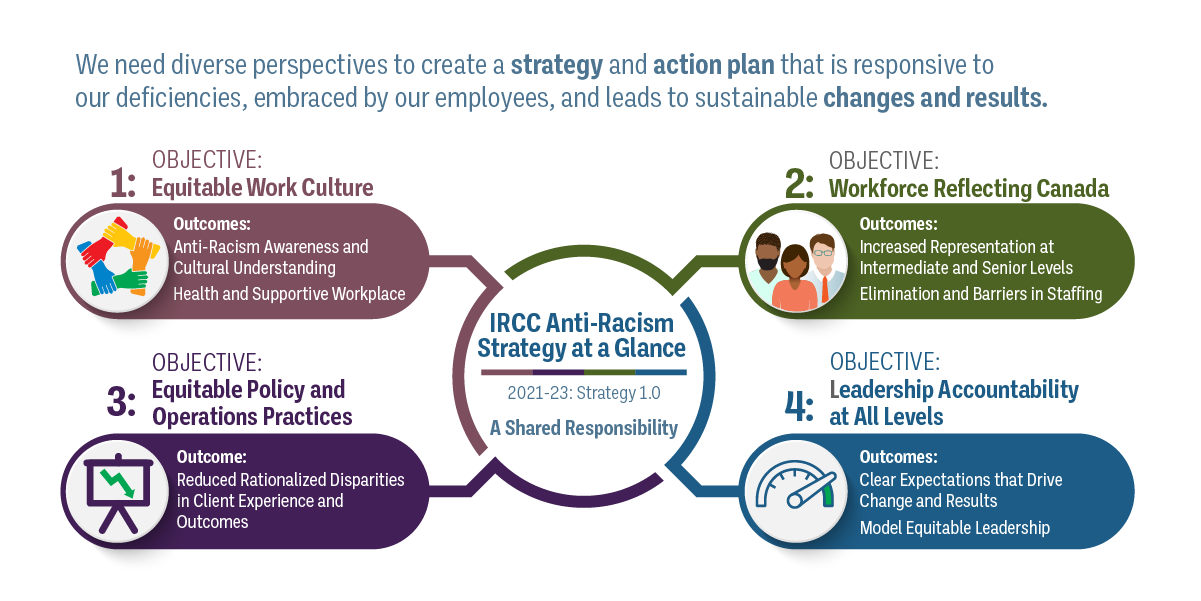
Text version: IRCC Anti-Racism Strategy at a Glance (2021–23: Strategy 1.0)
We need diverse perspectives to create a strategy and action plan that is responsive to our deficiencies, embraced by our employees, and leads to sustainable changes and results.
A Shared Responsibility
-
Objective: Equitable Work and Culture
Outcomes:
- Anti-Racism Awareness and Cultural Understanding
- Health and Supportive Workplace
-
Objective: Workforce Reflecting Canada
Outcomes:
- Increased Representation at Intermediate and Senior Levels
- Elimination and Barriers in Staffing
-
Objective: Equitable Policy and Operations Practices
Outcome:
- Reduced Rationalized Disparities in Client Experience and Outcomes
-
Objective: Leadership Accountability at All Levels
Outcomes:
- Clear Expectations that Drive Change and Results
- Model Equitable Leadership
The Task Force worked collaboratively with all branches within the organization to support the integration of anti-racism into the daily work of employees and in departmental policies, programs, and service delivery. The focus in 2021 was to set up a governance structure to facilitate diverse voices being brought together to inform an iterative departmental anti-racism strategy and actions.
In May 2021, the Department published its Value Statement to acknowledge the presence of racism in Canada and in the organization, and to reaffirm IRCC’s resolve to advance racial equity for all employees and clients. IRCC has also developed a set of anti-racism action commitments to outline how each sector of the Department will support anti-racism efforts over the next three years (2021–23). In addition, as per the Performance Management Corporate priorities for 2021–22 issued by the Clerk of the Privy Council, senior executives within the organization were mandated to incorporate Anti-Racism Commitments into a three-year plan that focuses on the recruitment, retention, and career advancement of equity seeking groups.
To build the momentum for creating lasting institutional change, the Department initiated key practices in the areas of people management, policy, and operations, including anti-racism coaching and training for leaders and staff, new workforce representation targets at all levels, career development programs for Indigenous, Black, and racialized employees, racial impact assessment tools for policy and program development, and program integrity and risk management tools for addressing decision-making bias in service delivery.
Gender and diversity considerations in immigration
Immigration, Refugees and Citizenship Canada (IRCC) is required under the Immigration and Refugee Protection Act to include a Gender-Based Analysis (GBA) Plus assessment of the impact of the Act in its Annual Report.
GBA Plus is a tool for understanding how multiple factors, such as race, ethnicity, gender, religion, disability, sexual orientation, education, income, language, indigeneity, and age shape health, social, and economic outcomes for people and influence access to programs and services. It is used in the design and implementation of policies, programs, and other initiatives so that they are more inclusive and responsive to the different needs of people. IRCC remains committed to working towards the full implementation of GBA Plus throughout its business lines to ensure that its initiatives are developed with equity, diversity, and inclusion in mind.
For example, IRCC used GBA Plus in the development of the new refugee stream for human rights defenders to ensure that the stream best met the needs of the human rights defenders most in need of protection. Identifying the human rights defenders most at risk involves attention to intersectional factors, including but not limited to defenders’ sexual orientation, gender identity or gender expression, ethnicity, language ability, and social positionality. In designing this stream, IRCC undertook extensive consultations, including with organizations specializing in or bringing a particular focus to the protection of women, LGBTQI, indigenous, or socially marginalized human rights defenders. IRCC recognizes that human rights defenders may face intersectional risks, including from their own communities or even families, due to their identity and work, which may challenge social norms. IRCC also recognizes that various groups of marginalized or stigmatized human rights defenders might face particular barriers to accessing protection. To address these challenges, IRCC secured the cooperation of two civil society organizations that devote particular attention to the protection of human rights defenders facing intersectional risks — Front Line Defenders and Protect Defenders.eu — to identify individuals to be resettled under this stream.
IRCC’s humanitarian commitment to Afghanistan includes a humanitarian stream designed to welcome diverse priority populations that experience increased marginalization and discrimination based on their particular vulnerabilities, including but not limited to women, LGBTQI people, human rights defenders, journalists and those who help them, and members of religious and ethnic minorities. The Department considered GBA Plus factors in the design of the Afghanistan resettlement initiative by partnering with referral organizations that are experts in identifying priority vulnerability factors for refugees. Specific allocations for referrals to each organization were provided in a manner that supports a balance in vulnerability and risk factors. More generally, the Afghan resettlement initiative has been designed to advance gender equality goals for Canada by offering protection and support to Afghan refugees and other at-risk Afghans by settling them in Canada permanently, regardless of whether Afghan women are the principal applicants or the dependants.
In 2021, IRCC made progress on several GBA Plus initiatives that were put in place during or before 2019.
GBA Plus Highlights at IRCC
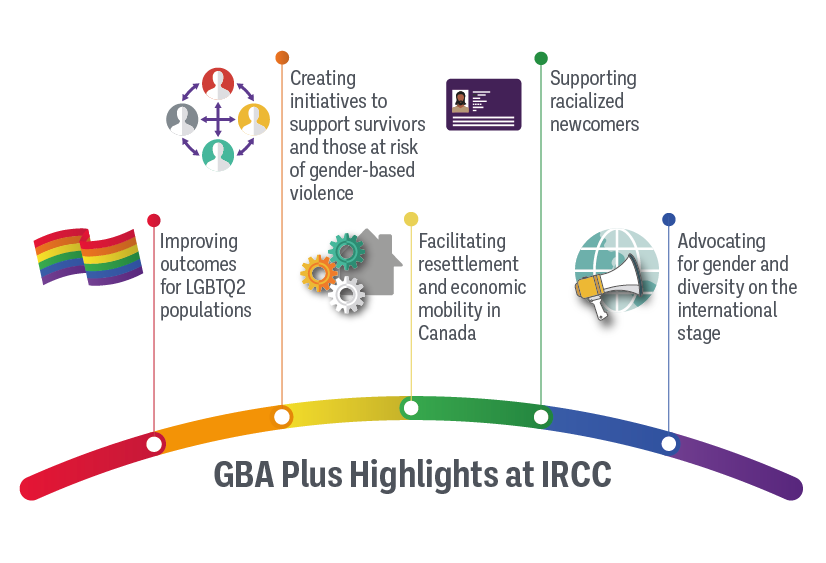
Text version: GBA Plus Highlights at IRCC
- Improving outcomes for LGBTQ2 populations
- Creating initiatives to support survivors and those at risk of gender-based violence
- Facilitating resettlement and economic mobility in Canada
- Supporting racialized newcomers
- Advocating for gender and diversity on the international stage
Improving outcomes for diverse populations
The Rainbow Refugee Assistance Partnership

Established in 2020, the Rainbow Refugee Assistance Partnership built on the success of the Rainbow Refugee Assistance Pilot by increasing the number of privately sponsored refugees from 15 to 50 per year. The Partnership was established in cooperation with the Rainbow Refugee Society, with the aim of encouraging more Canadians to support LGBTQI refugees and strengthening collaboration between LGBTQI organizations and the refugee settlement community in Canada.Footnote 16 In 2021, there were only 12 admissions of refugees through this partnership due to COVID-19 travel restrictions. However, in 2021, the partnership was expanded in response to the Afghanistan crisis, providing for an additional 150 spaces per year between 2022 and 2024.
IRCC’s Sex and Gender Client Identifier Policy

In alignment with the Treasury Board Secretariat Policy Direction to Modernize the Government of Canada’s Sex and Gender Information Practices, IRCC established a Departmental Sex and Gender Client Identifier Policy in 2021. The Policy sets out how a client’s sex or gender information should be collected, recorded, and displayed in the administration of all IRCC programs. As a result of past efforts under the Gender X Project, there has been significant work to implement the Policy. For example, all IRCC lines of business allow clients to request a non-intrusive change of their sex or gender identifier, including Female (“F”), Male (“M”), and Another Gender (“X”) on any IRCC-issued document. Moving forward, IRCC will suppress the display of this gender-related information on documents and correspondence where there is no substantiated need to include it.
Gender-Based Violence Strategy

In June 2017, the Government of Canada announced It’s Time: Canada’s Strategy to Prevent and Address Gender-Based Violence, the federal response to gender-based violence. The initiative focuses on three main areas of action: prevention, support for survivors and their families, and the promotion of responsive legal and justice systems. Under this federal strategy, IRCC received $1.5 million in funding over five years (2017–22) to further enhance the Settlement Program, which delivers pre- and post-arrival settlement services to newcomers to Canada. The funding is being used to develop and implement a settlement sector strategy on gender-based violence through a coordinated partnership of settlement and anti-violence sector organizations. In response to the increase in gender-based violence in the pandemic context, IRCC consulted with service provider organizations to better understand the situation for newcomers. As a result, IRCC issued guidance and information to organizations on the continuation of services considered essential, which included providing support to clients experiencing gender-based violence.
Canada’s federal Budget 2021 included additional funds to continue with enhancements to the Settlement Program to address gender-based violence. The Gender-Based Violence Strategy Partnership is a unique collaboration between settlement and anti-violence organizations to build the capacity of the sector to address gender-based violence for immigrants and refugees.
Canada’s Assistance to Women at Risk Program

The Canada’s Assistance to Women at Risk Program is designed to provide resettlement opportunities to women who are at increased risk of discrimination and violence, including those who are in precarious situations where local authorities cannot ensure their safety. Some women may need immediate protection in the short-term, while others are in permanently dangerous circumstances. Gender-based persecution is one of the grounds upon which Canada grants refugee protection. In 2021, Canada resettled 995 vulnerable refugee women and children through this program.
Measures to support newcomers to leave situations of family violence
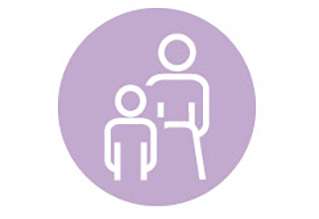
Measures to support newcomers to leave situations of family violence were introduced in 2019 and continued throughout 2021 to help individuals escape abuse. These measures included:
- An expedited, fee-exempt, temporary resident permit for individuals who lack status, which also gives individuals a work permit and temporary healthcare coverage under the Interim Federal Health program. In 2021, 167 permits were issued under this initiative.
- An expedited process for victims of family violence or abuse to apply for permanent residence on humanitarian and compassionate grounds. In 2021, 84 applicants under this process were approved.
Facilitating resettlement and economic mobility in Canada
Resettlement Assistance Program
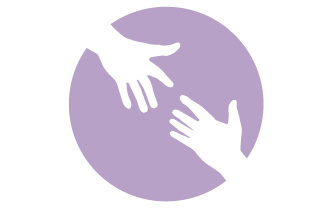
The Resettlement Assistance Program (RAP), a national Grants and Contribution program created in 1998 that operates in all provinces and territories, with the exception of Quebec, helps government-assisted refugees and other eligible clients when they first arrive in Canada. The program provides direct financial support and funds the provision of immediate and essential services. In 2021, IRCC’s Settlement Network created the Resettlement Operations Directorate to facilitate a more national approach to the management of this program, provided financial support to the Canadian resettlement network of service providers to coordinate work across the service providers delivering RAP, and completed a call for proposals that added nine new RAP agencies in smaller centres across Canada.
Supporting racialized newcomers
Racialized Newcomer Women Pilot

Programming under the Racialized Newcomer Women Pilot (formerly the Visible Minority Newcomer Women Pilot) is designed to support employment outcomes and career advancement for racialized newcomer women through the delivery of settlement services. Extensions were provided to 11 projects, originally anticipated to end in March 2021, that were best suited to continue direct service delivery to support racialized newcomer women as the economy recovers. Additionally, the Social Research and Demonstration Corporation, which is testing four specific employment models targeting racialized newcomer women, received additional funding to explore the applicability of the four models for Francophone racialized newcomer women and to undertake a retrospective study of the funding provided to partners and clients. Results from the Racialized Newcomer Women Pilot will inform employment settlement services for newcomer women.
Advocating for gender and diversity on the international stage
Internationally, IRCC applies GBA Plus to promote inclusive and participatory engagement abroad. The Department is working at the bilateral and multilateral levels to encourage dialogue and collaboration on migration management and refugee protection that is more gender-responsive and inclusive of a variety of identity factors for diverse newcomers.
Global Compact for Migration

In 2020, Canada accepted the opportunity to become a champion country of the Global Compact for Migration. In 2021, Canada used this platform internationally to share best practices related to gender-responsive migration management. Canada also funded migration capacity building projects and research to support gender-responsive migration management. Canada continued its commitment to gender-responsive migration as one of the key priorities in 2022 at the International Migration Review Forum, the first global review of the implementation of the Global Compact for Migration
Global Forum on Migration and Development
As part of Canada’s engagement in the Global Forum on Migration and Development, IRCC co-launched and is actively contributing to the implementation of a global communications campaign called It Takes a Community. The campaign aims to promote a more balanced narrative on migration by sharing inclusive stories about the positive contributions of migrants, including migrant women and girls, to communities worldwide.
Marco Integral Regional para la Protección y Soluciones (MIRPS) Support Platform
Forced displacement has grown significantly over the last few years in Central America and Mexico due to a variety of factors that have forced people to leave their homes, including violence, crime, and insecurity as well as a number of other economic, political and social factors. The MIRPS Support Platform was launched in December 2019 on the occasion of the first Global Refugee Forum.
The purpose of the Platform is to support the efforts of MIRPS countries (Belize, Costa Rica, El Salvador, Guatemala, Honduras, Mexico and Panama) in offering protection and solutions to forced displacement in Central America and Mexico. Its members include Argentina, Brazil, Canada, Colombia, the European Union, France, Spain, Switzerland, Uruguay, the United States of America, the Inter-American Development Bank, the World Bank, the Economic Commission for Latin America and the Caribbean, and the Organization of American States. The United Nations High Commissioner for Refugees (UNHCR) acts as the Secretariat for the Platform.
MIRPS countries set national action plans to articulate the needs and priorities for their efforts, including refugee protection, education, jobs and livelihoods, health and social protection. The Support Platform will help countries implement their action plans and serves as a mechanism for greater responsibility sharing between countries in addressing forced displacement challenges, as called for in the Global Compact on Refugees.
As Chair of the MIRPS Support Platform from July 2021 to September 2022, Canada helped countries achieve their goals by working to share relevant expertise and by mobilizing resources. Canada’s efforts centered around a Chair theme of “Protection and Empowerment of Women and Girls on the Move.” Activities drew attention to the international protection needs of forcibly displaced women and girls, as well as the need to uphold the human rights of other vulnerable populations in Central America and Mexico.
Annex 1: Section 94 and Section 22.1 of the Immigration and Refugee Protection Act
The following excerpt from the Immigration and Refugee Protection Act (IRPA), which came into force in 2002, outlines the requirements for Immigration, Refugees and Citizenship Canada to prepare an annual report to Parliament on immigration.
Reports to Parliament
94 (1) The Minister must, on or before November 1 of each year or, if a House of Parliament is not then sitting, within the next 30 days on which that House is sitting after that date, table in each House of Parliament a report on the operation of this Act in the preceding calendar year.
(2) The report shall include a description of
- (a) the instructions given under section 87.3 and other activities and initiatives taken concerning the selection of foreign nationals, including measures taken in cooperation with the provinces;
- (b) in respect of Canada, the number of foreign nationals who became permanent residents, and the number projected to become permanent residents in the following year;
- (b.1) in respect of Canada, the linguistic profile of foreign nationals who became permanent residents;
- (c) in respect of each province that has entered into a federal-provincial agreement described in subsection 9(1), the number, for each class listed in the agreement, of persons that became permanent residents and that the province projects will become permanent residents there in the following year;
- (d) the number of temporary resident permits issued under section 24, categorized according to grounds of inadmissibility, if any;
- (e) the number of persons granted permanent resident status under each of subsections 25(1), 25.1(1) and 25.2(1);
- (e.1) any instructions given under subsection 30(1.2), (1.41) or (1.43) during the year in question and the date of their publication; and
- (f) a gender-based analysis of the impact of this Act.
The following excerpt from IRPA outlines the Minister’s authority to declare when a foreign national may not become a temporary resident, which came into force in 2013, and the requirement to report on the number of such declarations.
Declaration
22.1 (1) The Minister may, on the Minister’s own initiative, declare that a foreign national, other than a foreign national referred to in section 19, may not become a temporary resident if the Minister is of the opinion that it is justified by public policy considerations.
(2) A declaration has effect for the period specified by the Minister, which is not to exceed 36 months.
(3) The Minister may, at any time, revoke a declaration or shorten its effective period.
(4) The report required under section 94 must include the number of declarations made under subsection (1) and set out the public policy considerations that led to the making of the declarations.
Annex 2: Tables
Table 1: Temporary Resident Permits and Extensions Issued in 2021 by Provision of Inadmissibility
| Description of Inadmissibility | Provision Under the Immigration and Refugee Protection Act | Total Number of Permits in 2021 | Male | Female | Gender X |
|---|---|---|---|---|---|
| Security (e.g., espionage, subversion, terrorism) | 34 | 1 | 1 | 0 | 0 |
| Human or international rights violations | 35 | 2 | 1 | 1 | 0 |
| Serious criminality (offence punishable by a term of imprisonment of at least 10 years in Canada or received a sentence in Canada of more than 6 months of imprisonment) | 36(1) | 134 | 116 | 18 | 0 |
| Criminality (convicted or committed an indictable offence, or two summary offences) | 36(2) | 602 | 499 | 102 | 1 |
| Organized criminality | 37 | 0 | 0 | 0 | 0 |
| Health grounds (danger to public health or public safety, excessive demand) | 38 | 0 | 0 | 0 | 0 |
| Financial reasons (unwilling or unable to support themselves or their dependants) | 39 | 7 | 2 | 5 | 0 |
| Misrepresentation | 40 | 48 | 29 | 19 | 0 |
| Cessation of refugee protection | 40.1 | 0 | 0 | 0 | 0 |
| Non-compliance with Act (e.g., no passport, no visa, work/study without authorization, medical check to be completed in Canada)Footnote 17 | 41 | 1,552 | 778 | 774 | 0 |
| Inadmissible family member | 42 | 4 | 2 | 2 | 0 |
| Other provisionsFootnote 18 | 4,337 | 2,139 | 2,196 | 2 | |
| Total | 6,687 | 3,567 | 3,117 | 3 |
Source: Immigration, Refugees and Citizenship Canada (IRCC), Enterprise Data Warehouse (Master Business Reporting) as of May 3, 2022.
Table 2: Permanent Residents Admitted in 2021 by Top 10 Source Countries
| Rank | Country | Total NumberFootnote 19 | Percentage (%) | Males | Females |
|---|---|---|---|---|---|
| 1 | India | 127,933 | 32 | 73,075 | 54,858 |
| 2 | China, People's Republic of | 31,001 | 8 | 13,418 | 17,583 |
| 3 | Philippines | 18,021 | 4 | 7,716 | 10,305 |
| 4 | Nigeria | 15,593 | 4 | 7,469 | 8,124 |
| 5 | France | 12,688 | 3 | 6,683 | 6,005 |
| 6 | United States of America | 11,951 | 3 | 5,990 | 5,956 |
| 7 | Brazil | 11,425 | 3 | 5,631 | 5,793 |
| 8 | Iran | 11,303 | 3 | 5,475 | 5,825 |
| 9 | Afghanistan | 8,569 | 2 | 4,274 | 4,295 |
| 10 | Pakistan | 8,476 | 2 | 4,274 | 4,202 |
| Total Top 10 | 256,960 | 63 | 134,005 | 122,946 | |
| All Other Source Countries | 149,039 | 37 | 73,506 | 75,530 | |
| Total | 405,999 | 100 | 207,511 | 198,476 | |
Source: IRCC, Chief Data Office (CDO), Permanent Residents Data as of March 31, 2022.
Table 3: Permanent Residents Admitted in 2021 by Intended Destination and Immigration Category
| Immigration Category | NL | PE | NS | NB | QC | ON | MB | SK | AB | BC | YT | NT | NU | Not Stated | Total |
|---|---|---|---|---|---|---|---|---|---|---|---|---|---|---|---|
| Economic | |||||||||||||||
| Federal Economic – High SkilledFootnote 20 | 298 | 487 | 1,720 | 679 | 0 | 92,868 | 1,332 | 1,285 | 9,535 | 31,096 | 90 | 56 | 13 | 0 | 139,459 |
| Federal Economic – CaregiverFootnote 21 | 1 | 0 | 1 | 1 | 126 | 1,450 | 15 | 30 | 469 | 704 | 1 | 7 | 3 | 0 | 2,808 |
| Federal Economic – BusinessFootnote 22 | 2 | 6 | 10 | 10 | 0 | 228 | 21 | 1 | 37 | 250 | 0 | 0 | 0 | 0 | 565 |
| Agri-Food Pilot | 0 | 6 | 0 | 0 | 0 | 105 | 0 | 0 | 2 | 74 | 0 | 0 | 0 | 0 | 187 |
| Atlantic Immigration Pilot Programs | 408 | 265 | 2,673 | 1,579 | 0 | 0 | 0 | 0 | 0 | 0 | 0 | 0 | 0 | 0 | 4,925 |
| Provincial Nominee ProgramFootnote 23 | 510 | 1,482 | 2,278 | 1,814 | 0 | 11,027 | 10,328 | 6,507 | 8,589 | 10,999 | 367 | 119 | 0 | 0 | 54,020 |
| Rural and Northern Immigration | 0 | 0 | 0 | 0 | 0 | 186 | 51 | 1 | 29 | 127 | 0 | 0 | 0 | 0 | 394 |
| Federal Economic – Public PoliciesFootnote 24 | 105 | 159 | 919 | 413 | 0 | 12,935 | 1,078 | 414 | 1,696 | 6,087 | 52 | 26 | 2 | 0 | 23,886 |
| Quebec Skilled Workers | 0 | 0 | 0 | 0 | 25,042 | 0 | 0 | 0 | 0 | 0 | 0 | 0 | 0 | 0 | 25,042 |
| Quebec Business Immigrants | 0 | 0 | 0 | 0 | 1,685 | 0 | 0 | 0 | 0 | 0 | 0 | 0 | 0 | 0 | 1,685 |
| Total Economic | 1,324 | 2,405 | 7,601 | 4,496 | 26,853 | 118,799 | 12,825 | 8,238 | 20,357 | 49,337 | 510 | 208 | 18 | 0 | 252,971 |
| Family | |||||||||||||||
| Sponsored Spouses, Partners and Children | 162 | 128 | 688 | 400 | 12,070 | 31,100 | 1,939 | 1,257 | 9,002 | 12,381 | 66 | 69 | 16 | 0 | 69,278 |
| Sponsored Parents and Grandparents | 14 | 3 | 42 | 15 | 1,756 | 5,438 | 398 | 392 | 1,801 | 1,869 | 6 | 4 | 0 | 0 | 11,738 |
| Sponsored Family – OtherFootnote 25 | 0 | 0 | 2 | 1 | 69 | 136 | 5 | 6 | 140 | 46 | 1 | 1 | 0 | 0 | 407 |
| Total Family | 176 | 131 | 732 | 416 | 13,895 | 36,674 | 2,342 | 1,655 | 10,943 | 14,296 | 73 | 74 | 16 | 0 | 81,423 |
| Refugees and Protected Persons in-Canada | |||||||||||||||
| Protected Persons in-Canada and Dependants of Protected Person | 15 | 13 | 67 | 38 | 5,685 | 27,379 | 383 | 84 | 2,912 | 3,217 | 2 | 3 | 2 | 0 | 39,800 |
| Blended Visa Office-Referred Refugees | 0 | 0 | 9 | 0 | 0 | 41 | 11 | 0 | 2 | 13 | 0 | 0 | 0 | 0 | 76 |
| Government‑Assisted RefugeesFootnote 26 | 455 | 50 | 518 | 285 | 963 | 4,692 | 383 | 681 | 1,502 | 1,266 | 0 | 0 | 0 | 16 | 10,811 |
| Privately Sponsored Refugees | 45 | 3 | 156 | 59 | 637 | 4,338 | 450 | 252 | 2,908 | 677 | 4 | 11 | 0 | 1 | 9,541 |
| Total Refugees and Protected Persons in-Canada | 519 | 84 | 626 | 395 | 7,296 | 35,618 | 1,237 | 1,024 | 7,977 | 5,019 | 6 | 14 | 2 | 411 | 60,228 |
| Humanitarian and Other | |||||||||||||||
| Humanitarian and OtherFootnote 27 | 40 | 11 | 68 | 14 | 2,241 | 7,346 | 179 | 38 | 764 | 665 | 7 | 1 | 3 | 0 | 11,377 |
| Total Humanitarian and Other | 40 | 11 | 68 | 14 | 2,241 | 7,346 | 179 | 38 | 764 | 665 | 7 | 1 | 3 | 0 | 11,377 |
| Total | 2,059 | 2,631 | 9,027 | 5,321 | 50,285Footnote 28 | 198,437 | 16,583 | 10,955 | 40,041 | 69,317 | 596 | 297 | 39 | 411 | 405,999 |
| Percentage | 0.5% | 0.6% | 2.2% | 1.3% | 12.4% | 48.9% | 4.1% | 2.7% | 9.9% | 17.1% | 0.1% | 0.1% | 0.0% | 0.1% | 100.0% |
Source: IRCC, CDO, Permanent Resident Data as of March 31, 2022.
Table 4: Permanent Residents Admitted in 2021
| Immigration Category | 2021 Planned Admissions Range | 2021 Admissions | ||||
|---|---|---|---|---|---|---|
| Low | High | Female | Male | Gender XFootnote 29 | Total | |
| Federal Economic – High SkilledFootnote 30 | 81,000 | 110,250 | 64,090 | 75,369 | 0 | 139,459 |
| Federal Economic Pilots – Caregivers,Footnote 31 Agri-Food and Rural and Northern Immigration Pilot |
4,900 | 9,250 | 2,326 | 1,063 | 0 | 3,389 |
| Federal Economic – BusinessFootnote 32 | 400 | 1,250 | 284 | 281 | 0 | 565 |
| Federal Economic – Public PoliciesFootnote 33 | - | - | 9,735 | 14,151 | 0 | 23,886 |
| Atlantic Immigration Pilot | 3,300 | 6,250 | 2,290 | 2,635 | 0 | 4,925 |
| Provincial Nominee ProgramFootnote 34 | 64,000 | 81,500 | 24,548 | 29,471 | 1 | 54,020 |
| Quebec Skilled Workers and BusinessFootnote 35 | 26,900 | 28,500 | 12,409 | 14,318 | 0 | 26,727 |
| Economic Total | 180,500 | 237,000 | 115,682 | 137,288 | 1 | 252,971 |
| Spouses, Partners and Children | 61,000 | 81,000 | 40,125 | 29,147 | 6 | 69,278 |
| Parents and Grandparents | 15,000 | 24,000 | 7,079 | 4,659 | 0 | 11,738 |
| Family – OtherFootnote 36 | - | - | 212 | 195 | 0 | 407 |
| Family Total | 76,000 | 105,000 | 47,416 | 34,001 | 6 | 81,423 |
| Protected Persons in-Canada and Dependants Abroad | 17,000 | 25,000 | 19,319 | 20,480 | 1 | 39,800 |
| Blended Visa Office-Referred Refugees | 100 | 1,000 | 37 | 39 | 0 | 76 |
| Government-Assisted RefugeesFootnote 37 | 7,500 | 13,000 | 5,337 | 5,474 | 0 | 10,811 |
| Privately Sponsored Refugees | 14,900 | 23,000 | 4,244 | 5,294 | 3 | 9,541 |
| Refugees and Protected Persons Total | 39,500 | 62,000 | 28,937 | 31,287 | 4 | 60,228 |
| Humanitarian and Other TotalFootnote 38 | 4,000 | 6,000 | 6,441 | 4,935 | 1 | 11,377 |
| Total | 300,000 | 410,000 | 198,476 | 207,511 | 12 | 405,999 |
Source: IRCC, CDO, Permanent Resident Data as of March 31, 2022.
Table 5: Permanent Residents by Official Language Spoken, 2021
| English | French | French and English | Neither | Not Stated | Total | |
|---|---|---|---|---|---|---|
| Economic – Principal applicants | 149,207 | 3,693 | 16,533 | 273 | 173 | 169,879 |
| Female | 61,030 | 1,495 | 7,004 | 96 | 78 | 69,703 |
| Male | 88,177 | 2,198 | 9,529 | 177 | 95 | 100,176 |
| Gender X | 0 | 0 | 0 | 0 | 0 | 0 |
| Economic – Partners and dependants | 66,368 | 4,314 | 5,642 | 5,986 | 782 | 83,092 |
| Female | 36,770 | 2,409 | 3,367 | 2,949 | 484 | 45,979 |
| Male | 29,597 | 1,905 | 2,275 | 3,037 | 298 | 37,112 |
| Gender X | 1 | 0 | 0 | 0 | 0 | 1 |
| Total Economic | 215,575 | 8,007 | 22,175 | 6,259 | 955 | 252,971 |
| Female | 97,800 | 3,904 | 10,371 | 3,045 | 562 | 115,682 |
| Male | 117,774 | 4,103 | 11,804 | 3,214 | 393 | 137,288 |
| Gender X | 1 | 0 | 0 | 0 | 0 | 1 |
| Family reunification – Principal applicants | 51,732 | 3,873 | 4,723 | 9,115 | 255 | 69,698 |
| Female | 30,166 | 2,399 | 2,600 | 5,478 | 120 | 40,763 |
| Male | 21,561 | 1,474 | 2,123 | 3,636 | 135 | 28,929 |
| Gender X | 5 | 0 | 0 | 1 | 0 | 6 |
| Family reunification – Partners and dependants | 5,327 | 988 | 272 | 4,721 | 417 | 11,725 |
| Female | 2,961 | 517 | 154 | 2,800 | 221 | 6,653 |
| Male | 2,366 | 471 | 118 | 1,921 | 196 | 5,072 |
| Total Family Reunification | 57,059 | 4,861 | 4,995 | 13,836 | 672 | 81,423 |
| Female | 33,127 | 2,916 | 2,754 | 8,278 | 341 | 47,416 |
| Male | 23,927 | 1,945 | 2,241 | 5,557 | 331 | 34,001 |
| Gender X | 5 | 0 | 0 | 1 | 0 | 6 |
| Refugees and protected persons in-Canada – Principal applicants | 20,087 | 1,485 | 1,584 | 7,877 | 837 | 31,870 |
| Female | 7,403 | 769 | 706 | 3,728 | 351 | 12,957 |
| Male | 12,681 | 716 | 878 | 4,149 | 486 | 18,910 |
| Gender X | 3 | 0 | 0 | 0 | 0 | 3 |
| Refugees and protected persons in-Canada – Partners and dependants | 12,805 | 1,009 | 897 | 11,670 | 1,977 | 28,358 |
| Female | 7,379 | 583 | 493 | 6,457 | 1,068 | 15,980 |
| Male | 5,426 | 426 | 404 | 5,212 | 909 | 12,377 |
| Gender X | 0 | 0 | 0 | 1 | 0 | 1 |
| Total Refugees and Protected Persons in‑Canada | 32,892 | 2,494 | 2,481 | 19,547 | 2,814 | 60,228 |
| Female | 14,782 | 1,352 | 1,199 | 10,185 | 1,419 | 28,937 |
| Male | 18,107 | 1,142 | 1,282 | 9,361 | 1,395 | 31,287 |
| Gender X | 3 | 0 | 0 | 1 | 0 | 4 |
| All other immigration – Principal applicants | 3,966 | 657 | 388 | 447 | 346 | 5,804 |
| Female | 2,440 | 433 | 213 | 304 | 229 | 3,619 |
| Male | 1,526 | 224 | 175 | 143 | 117 | 2,185 |
| All other immigration – Partners and dependants | 3,985 | 516 | 473 | 230 | 369 | 5,573 |
| Female | 2,005 | 266 | 222 | 165 | 164 | 2,822 |
| Male | 1,979 | 250 | 251 | 65 | 205 | 2,750 |
| Gender X | 1 | 0 | 0 | 0 | 0 | 1 |
| Total All Other Immigration | 7,951 | 1,173 | 861 | 677 | 715 | 11,377 |
| Female | 4,445 | 699 | 435 | 469 | 393 | 6,441 |
| Male | 3,505 | 474 | 426 | 208 | 322 | 4,935 |
| Gender X | 1 | 0 | 0 | 0 | 0 | 1 |
Source: IRCC, CDO, Permanent Resident Data as of March 31, 2022.
Annex 3: Temporary migration reporting
Temporary resident permits
Under subsection 24(1) of the Immigration and Refugee Protection Act (IRPA), an officer may issue a temporary resident permit (TRP) to a foreign national who is inadmissible or who does not otherwise meet the requirements of the Act, to allow that individual to enter or remain in Canada when it is justified under the circumstances. TRPs are issued for a limited period of time and are subject to cancellation at any time.
Table 1 in Annex 2 illustrates the number of TRPs issued in 2021, categorized according to grounds of inadmissibility under IRPA. In 2021, a total of 6,687 such permits were issued.
Public policy exemptions for a temporary purpose
In 2021, a total of 95 applications for temporary residence were granted under the public policy authority provided under subsection 25.2(1) of IRPA for certain inadmissible foreign nationals to facilitate their temporary entry into Canada as visitors, students, or workers. The public policy exemption has been in place since September 2010 to advance Canada’s national interests while continuing to ensure the safety of Canadians.
Use of the negative discretion authority
In 2021, the Minister of Immigration, Refugees and Citizenship did not use the negative discretion authority under subsection 22.1(1) of IRPA. This authority allows the Minister to make a declaration that, on the basis of public policy considerations, a foreign national may not become a temporary resident for a period of up to three years.
Annex 4: Ministerial Instructions
The Immigration and Refugee Protection Act (IRPA) provides the legislative authority for Canada’s immigration programs and contains various provisions that allow the Minister to issue special instructions to immigration officers to enable the Government of Canada to best achieve its immigration goals. These instructions are typically issued for limited periods of time and can touch on a diverse range of issues.
As required by section 94(2) of IRPA, the following table provides a description of the instructions given by the Minister in 2021 and the date of their publication.
| Title | Description | Date of Publication | Coming into Force |
|---|---|---|---|
| Ministerial Instructions with respect to the submission of online applications for temporary resident visas and other documents due to reduced processing capacity during the COVID-19 (Coronavirus) pandemic | Pursuant to section 87.3 of the Immigration and Refugee Protection Act, these instructions require that all applications for a Temporary Resident Visa (including a Transit Visa), a work permit, or a study permit submitted by foreign nationals who are outside Canada at the time of application must be submitted using electronic means (apply online). | February 1, 2021 | September 30, 2021 |
| Ministerial Instructions for out-of-status construction workers in the Greater Toronto Area | Pursuant to subsection 24(3) of the Immigration and Refugee Protection Act, the objective of these instructions is to grant foreign nationals (and their family members) applying to the Temporary public policy to further facilitate access to permanent resident status for out-of-status construction workers in the Greater Toronto Area or the Temporary public policy for out-of-status construction workers in the Greater Toronto Area the authorization to remain in Canada, when applicable, while their application for permanent residence is processed. | May 24, 2021 | July 30, 2021 |
| Ministerial Instructions regarding the processing of applications under the Home Support Worker Class and Home Child Care Provider Class | Pursuant to 87.3(6) of the Immigration and Refugee Protection Act, on May 3, 2021, Ministerial Instructions (MI46) were issued to establish how applications under the Home Child Care Provider and Home Support Worker classes would be managed. These instructions ensure that the number of applications received does not exceed the number that can be processed in a year under the Act. | May 3, 2021 | May 15, 2021 |
| Ministerial Instructions 47 (MI47): Ministerial Instructions with respect to the submission of online applications for temporary resident visas and other documents due to reduced processing capacity during the COVID-19 (Coronavirus) pandemic | Pursuant to section 87.3 and subsections 92(1.1) and (2) of the Immigration and Refugee Protection Act, these instructions require that all applications for a Temporary Resident Visa (including a Transit Visa), a work permit, or a study permit submitted by foreign nationals who are outside Canada at the time of application must be submitted using electronic means (apply online). | September 1, 2021 | March 31, 2022 |
| Ministerial Instructions 48 (MI48): Parents and Grandparents | Effective August 4, 2021, new Ministerial Instructions were issued to amend the Ministerial Instructions that came into effect on September 29, 2020 (MI43). The amendment increases the number of complete parent and grandparent sponsorship applications that will be accepted for processing in 2021 from 10,000 to 40,000. The amendment removes the 90-day extension to submit missing documentation due to service disruptions caused by COVID-19 for those who apply on or after the coming into force of these Instructions. | July 31, 2021 | August 4, 2021 |
| Ministerial Instructions 49 (MI49) and 50 (MI50): Parents and Grandparents | Given that the Department received 30,000 new applications for the Parents and Grandparents Program in 2021, many of which were received in December, as of January 1, 2022, new Ministerial Instructions (MI50) were issued to provide the authority in the 2022 calendar year to accept any remaining parent and grandparent sponsorship applications received in 2021 into processing. | December 10, 2021 | December 10, 2021 |